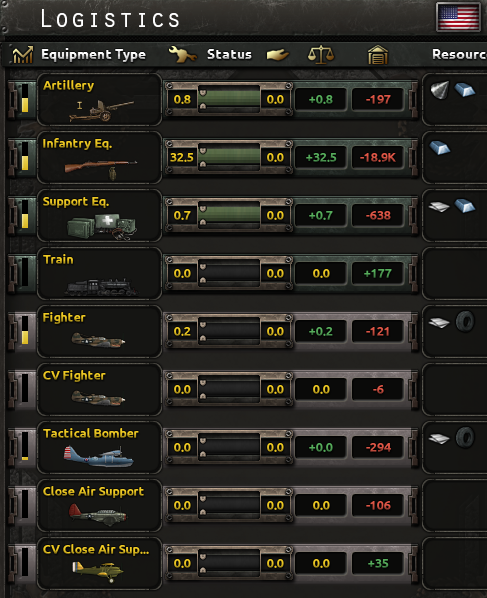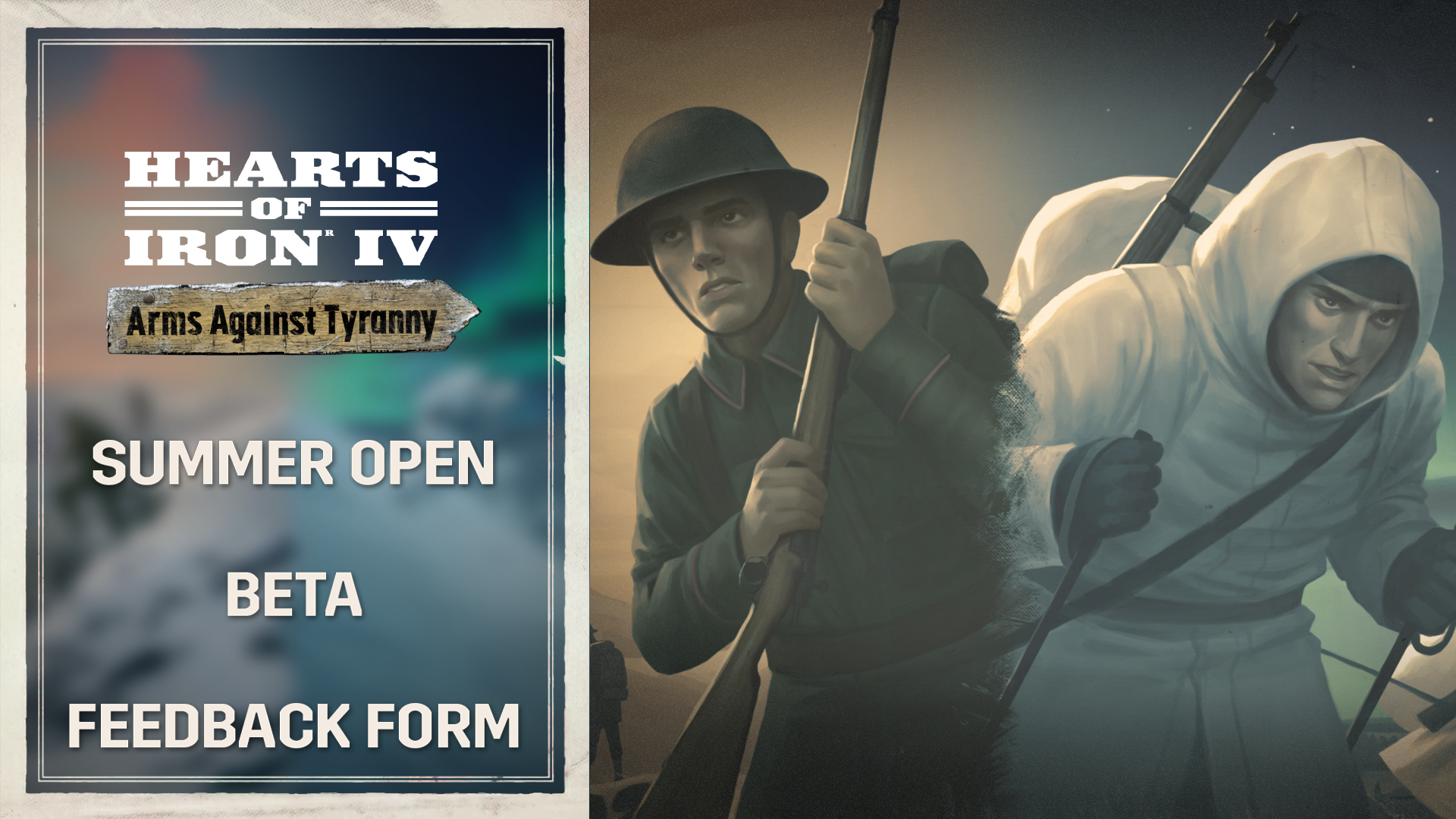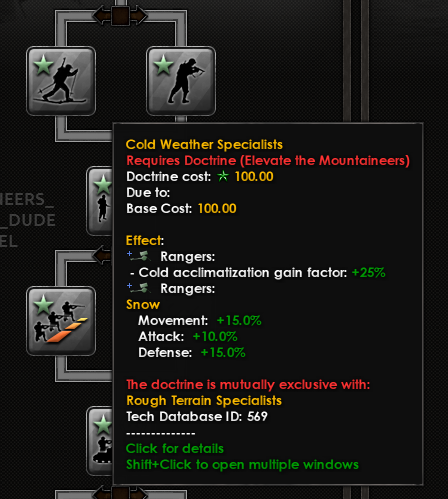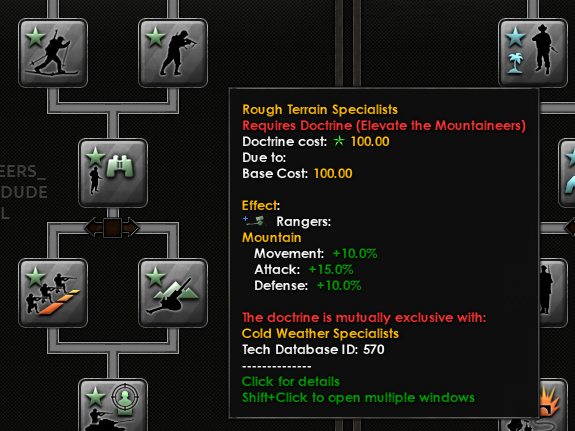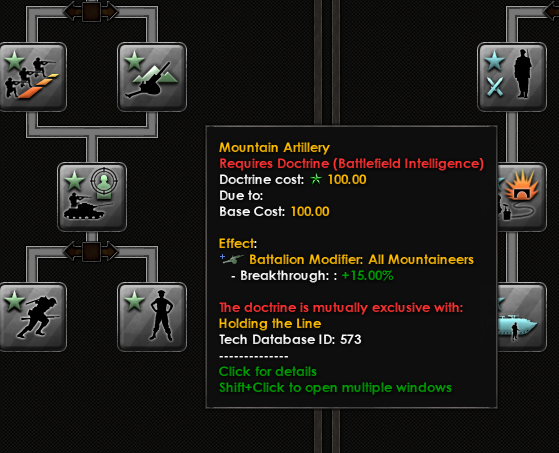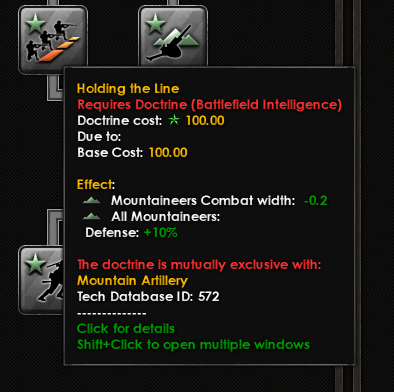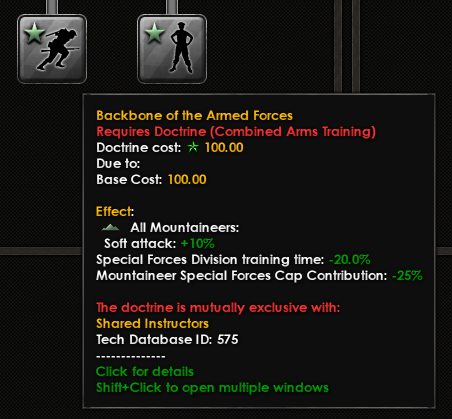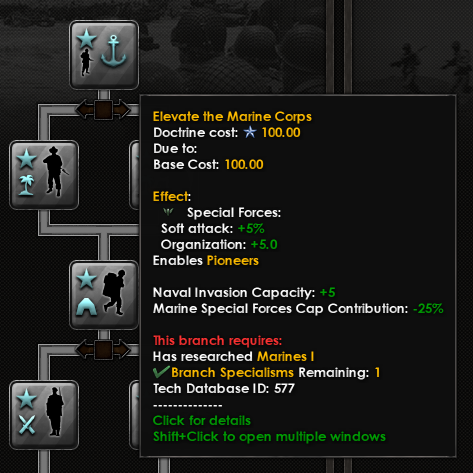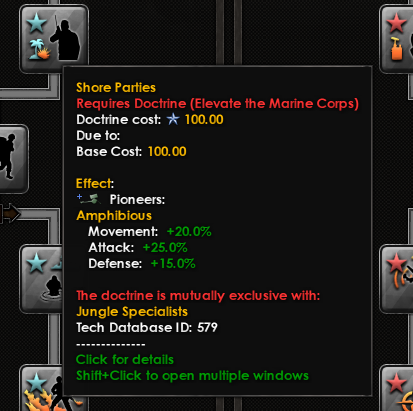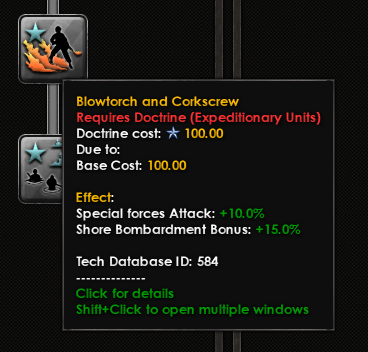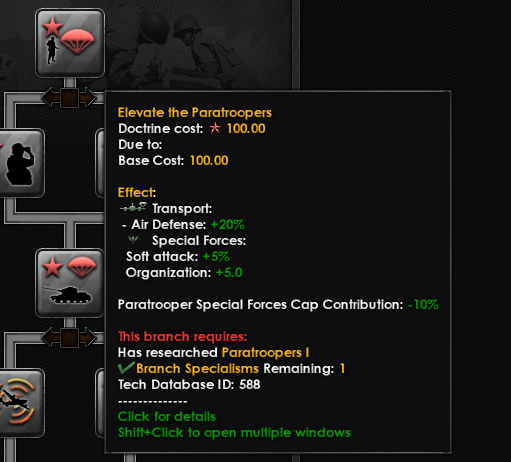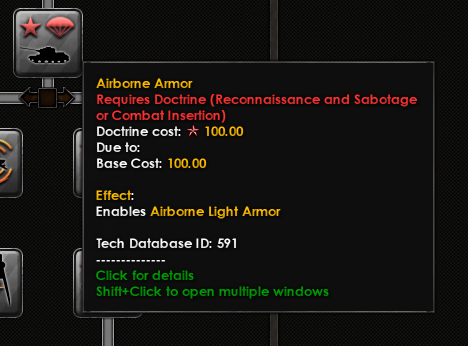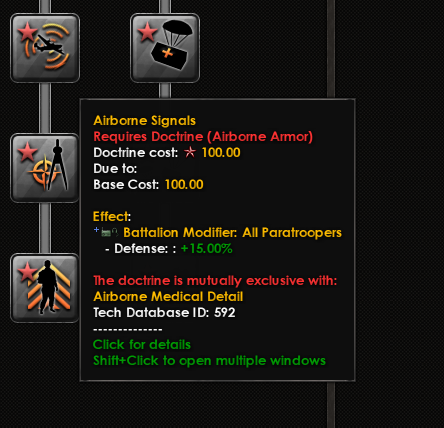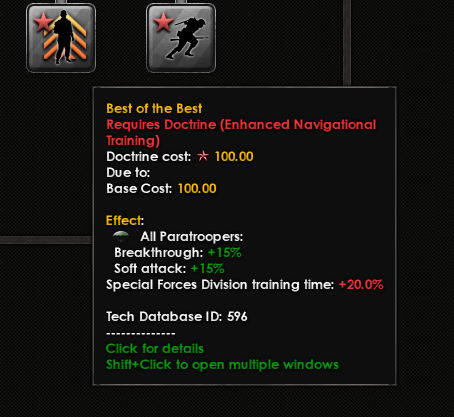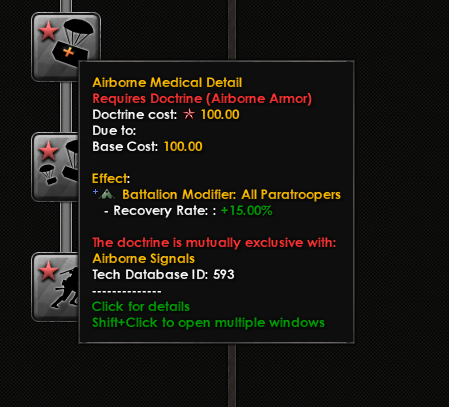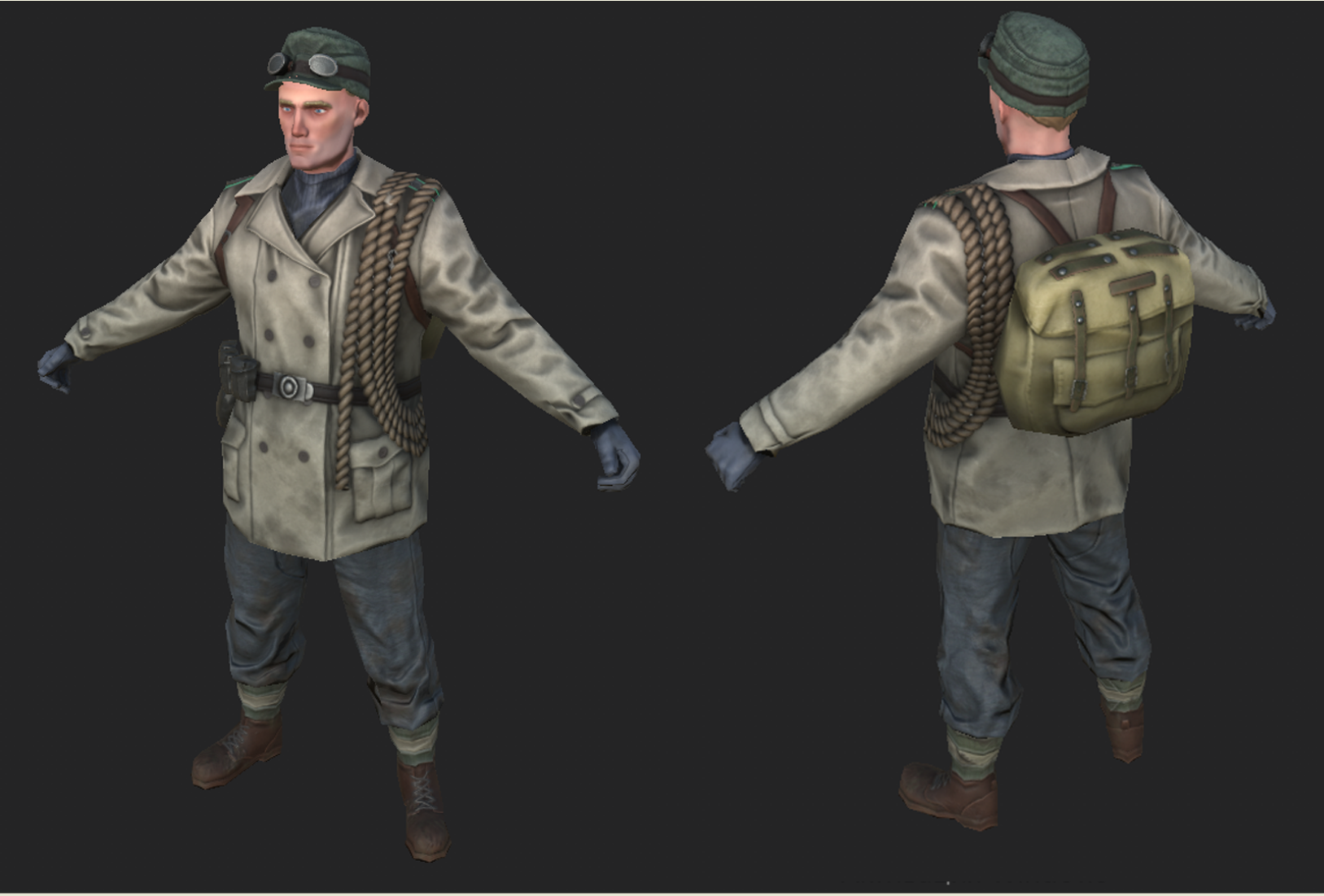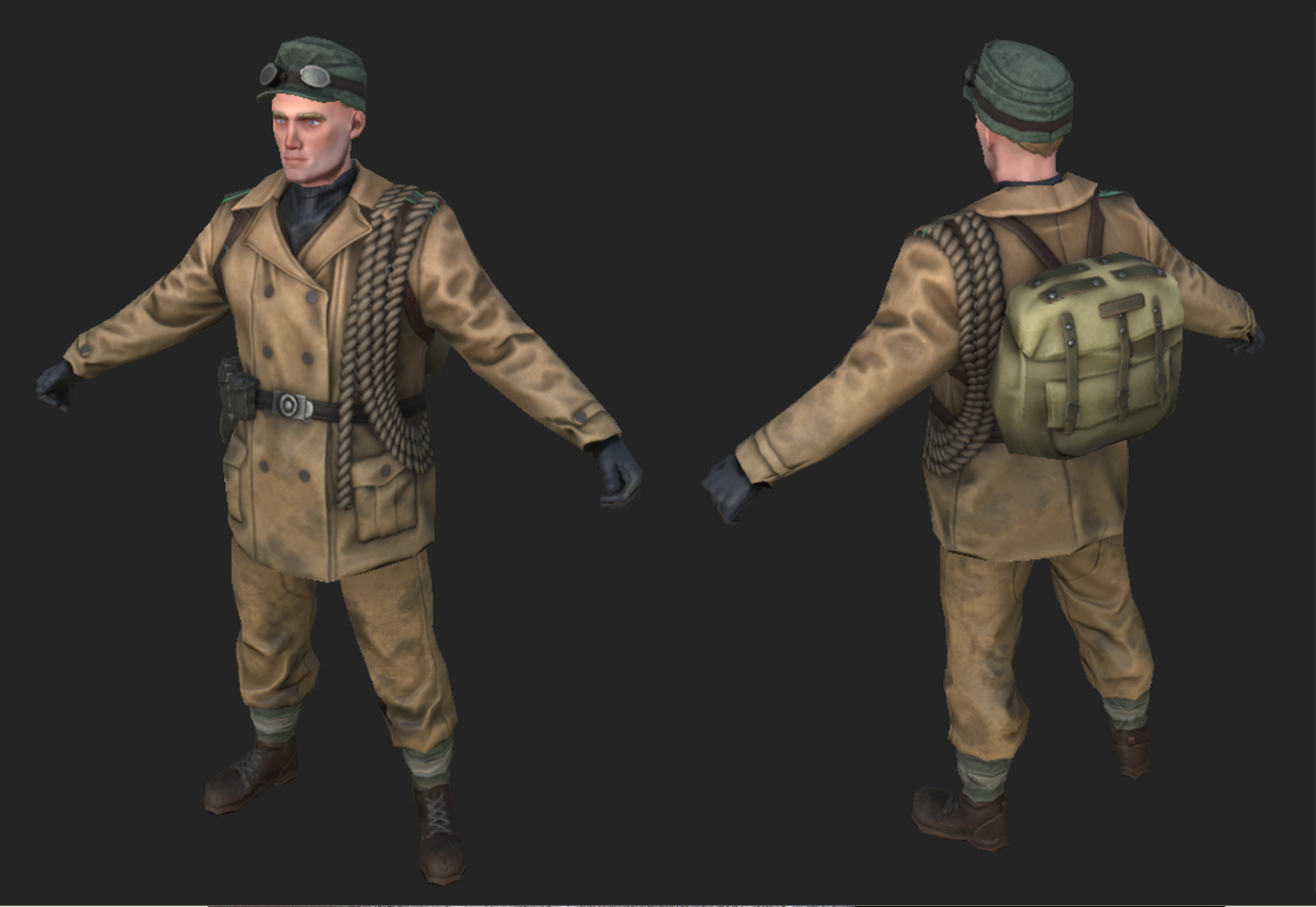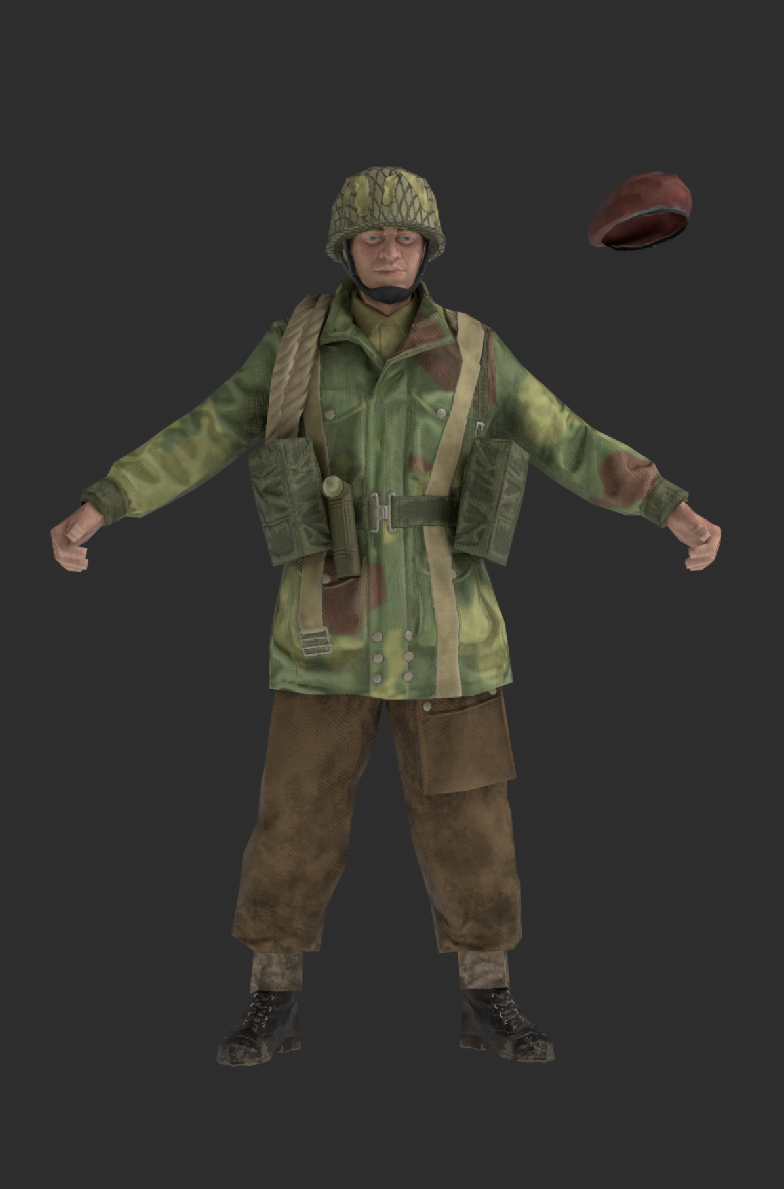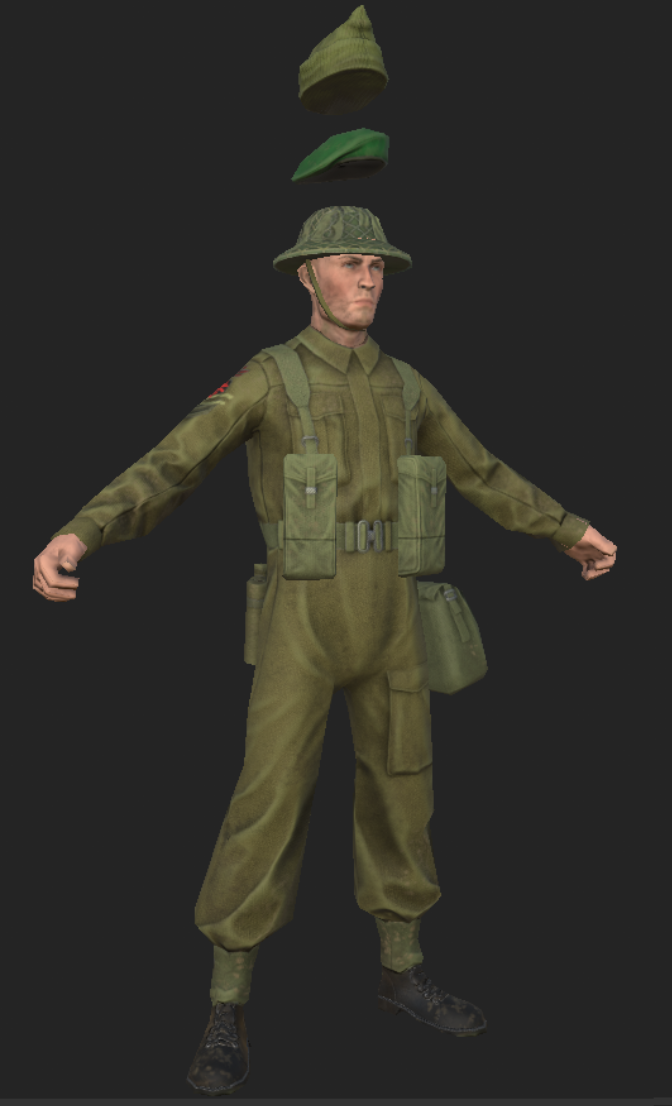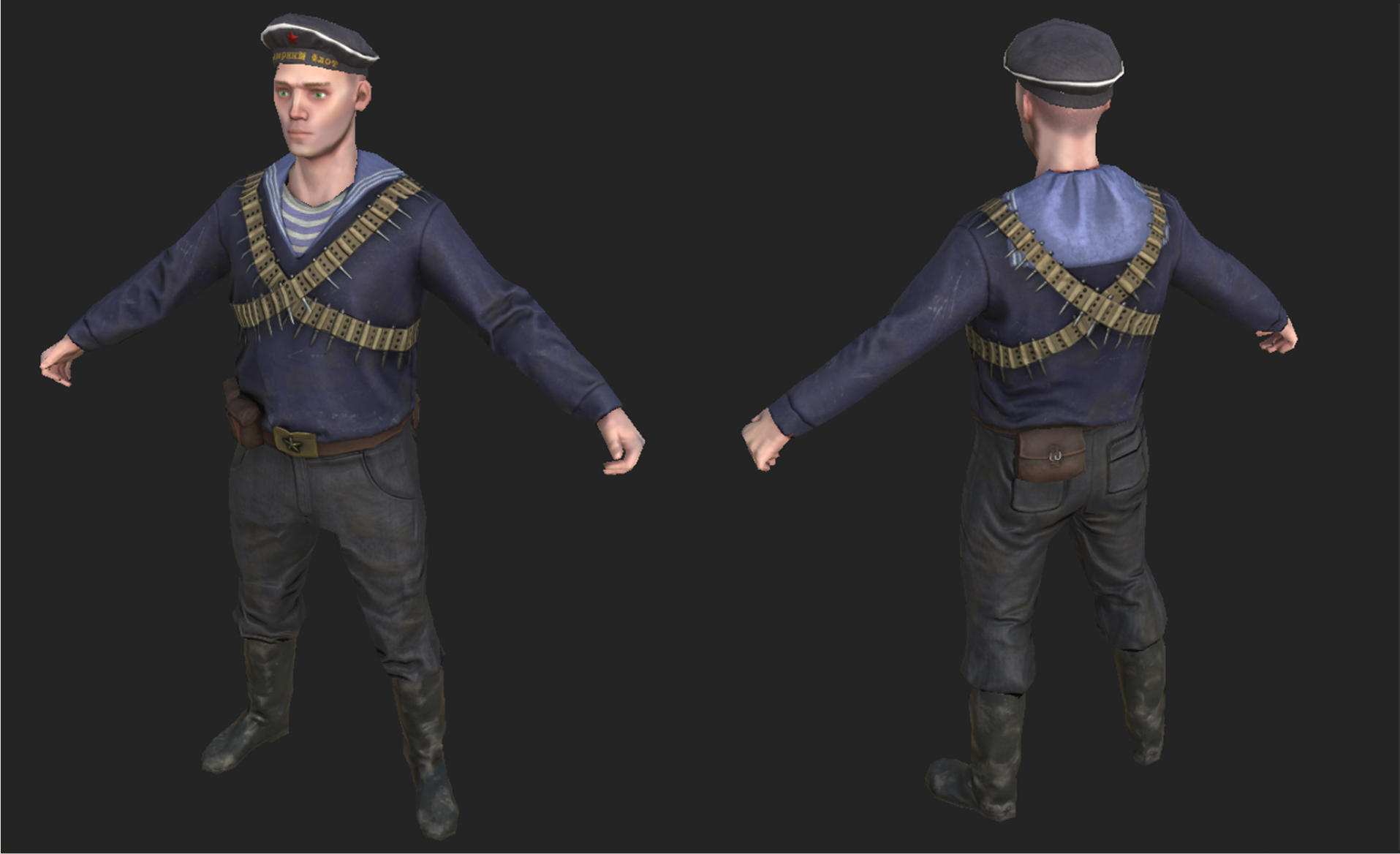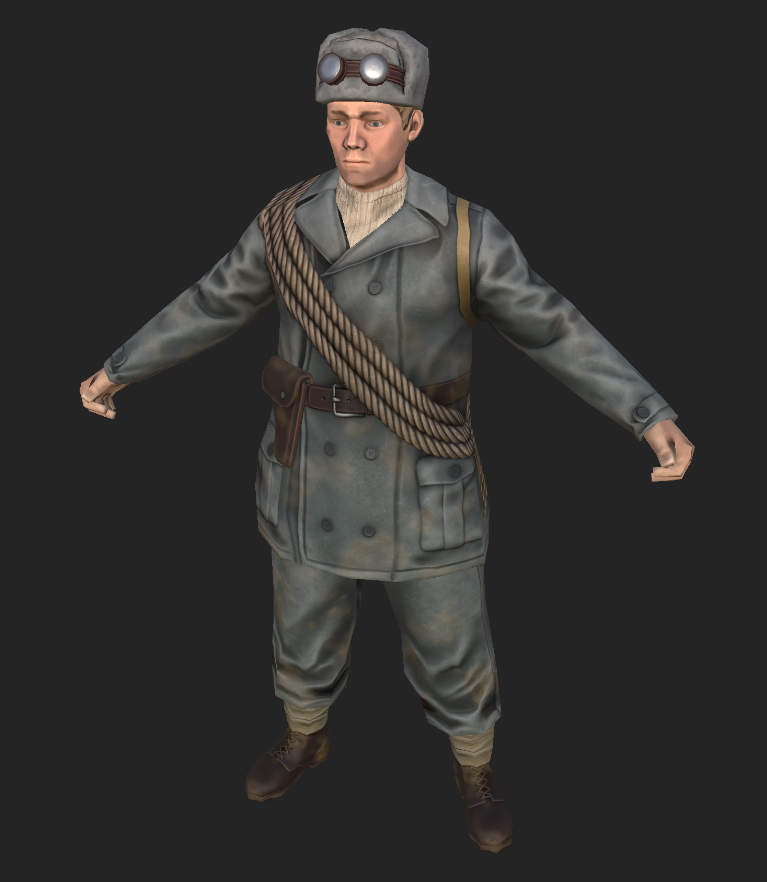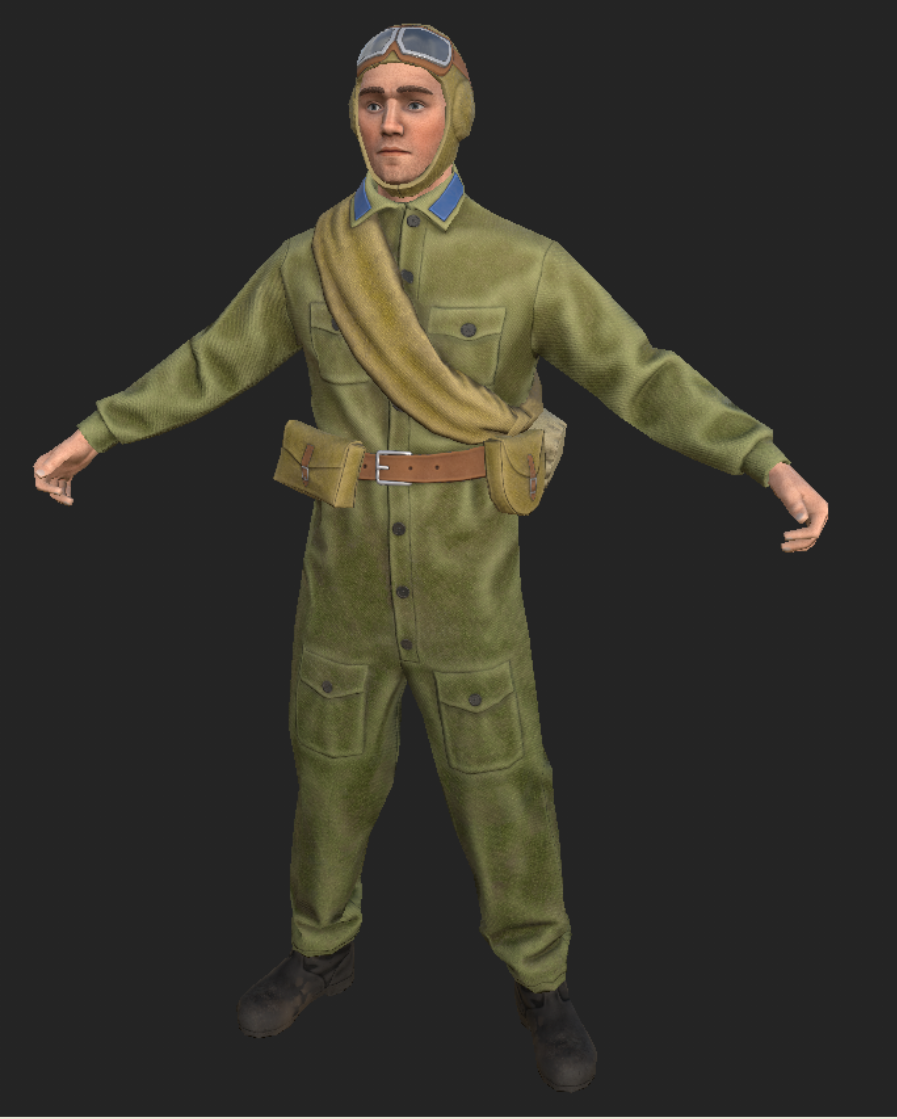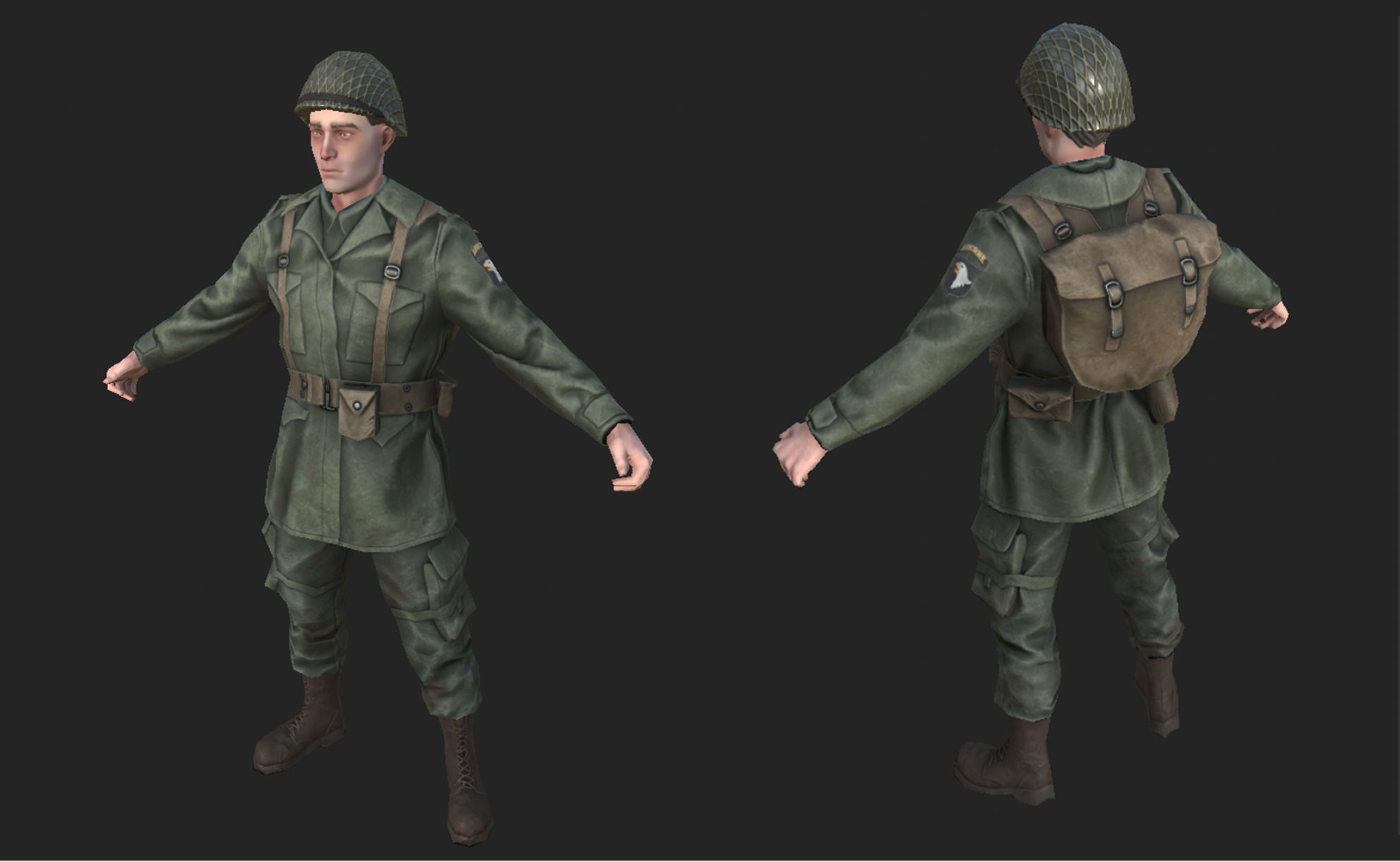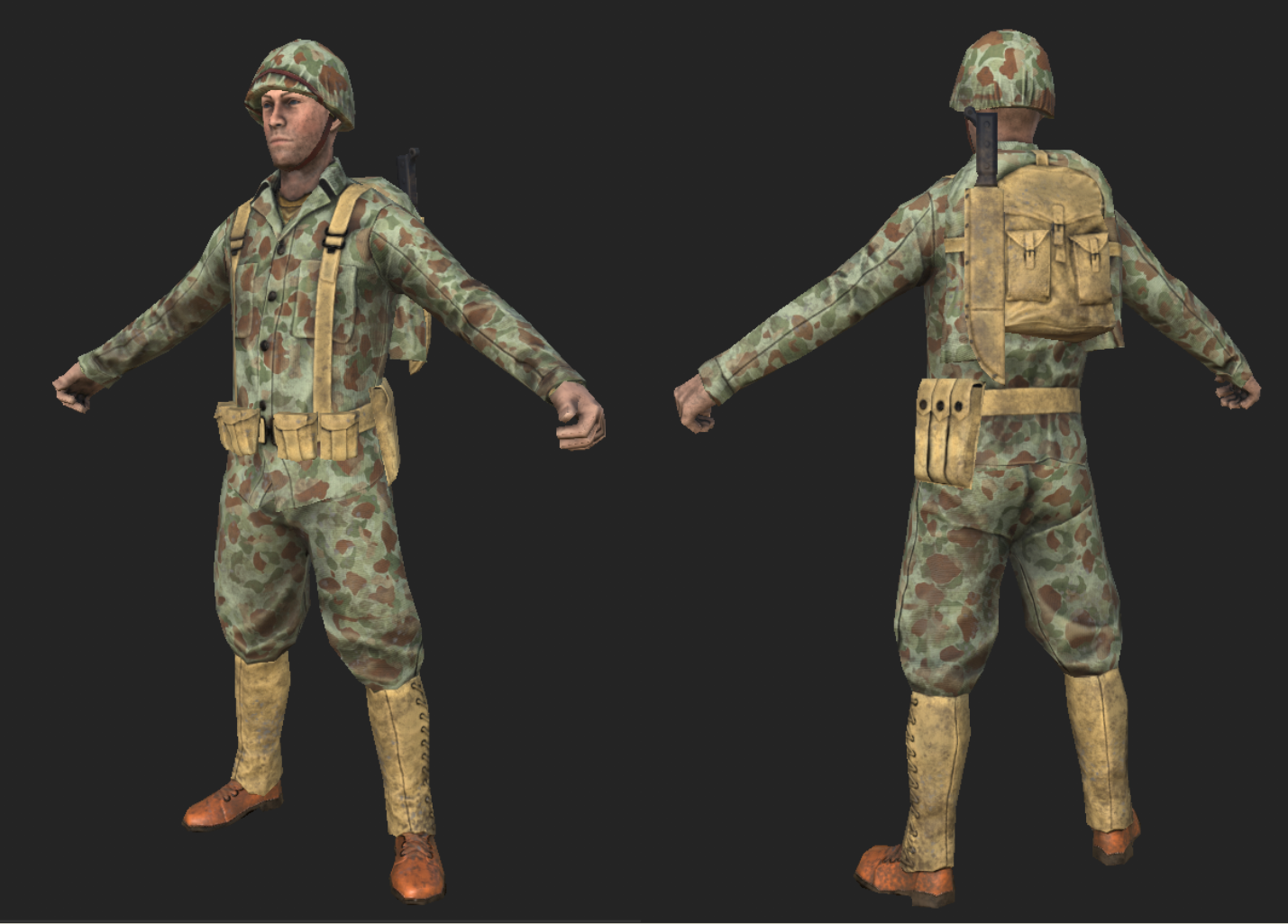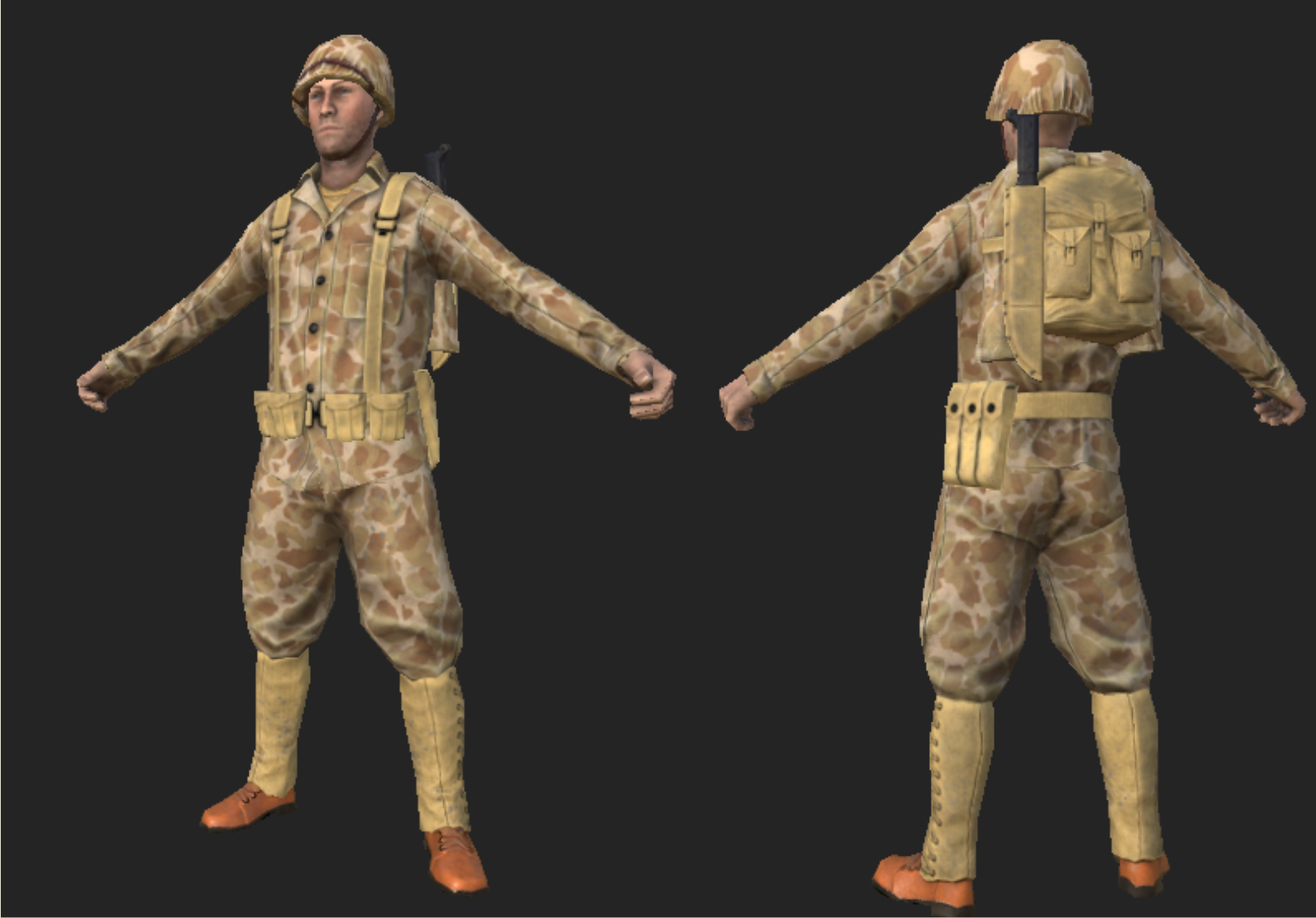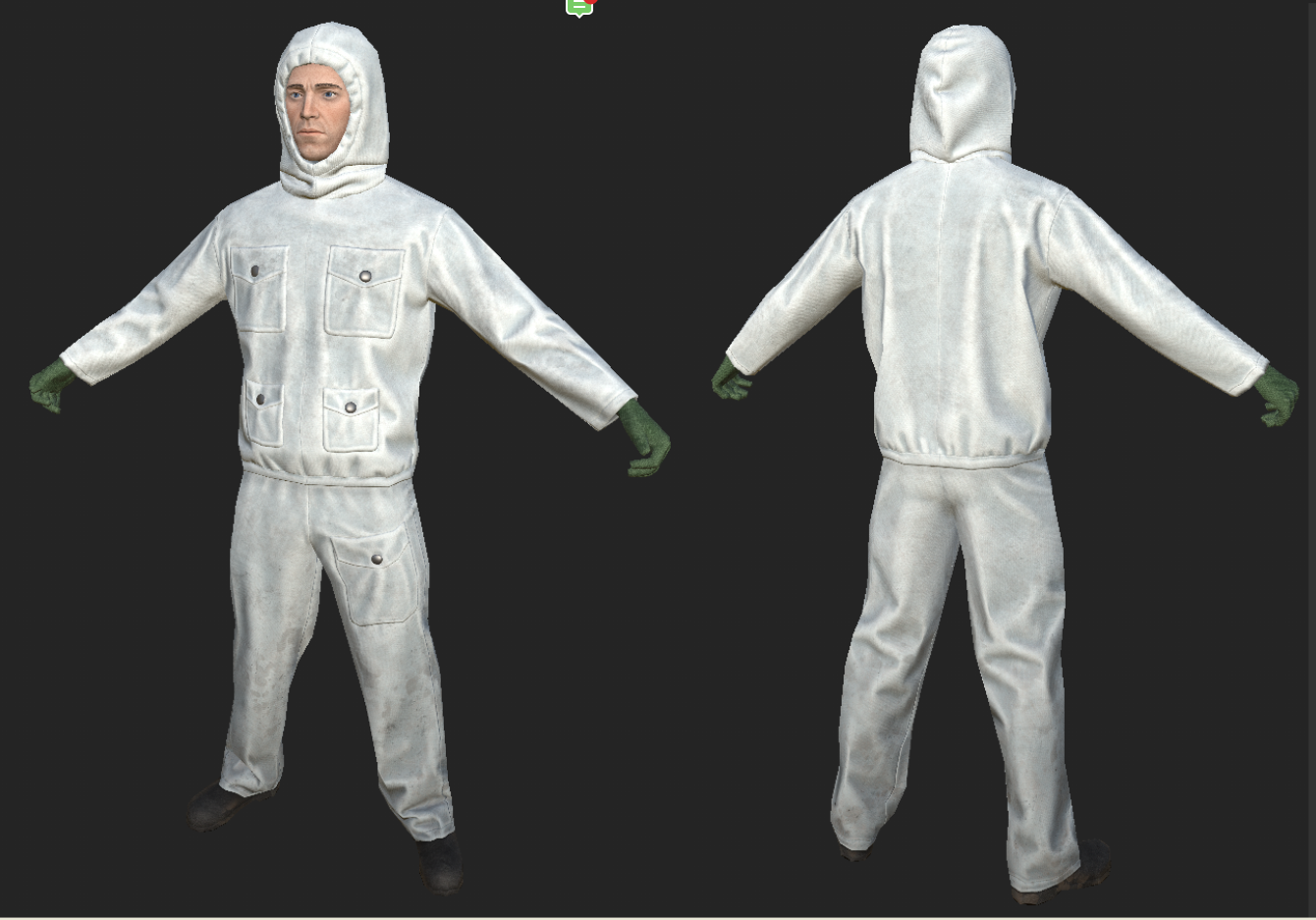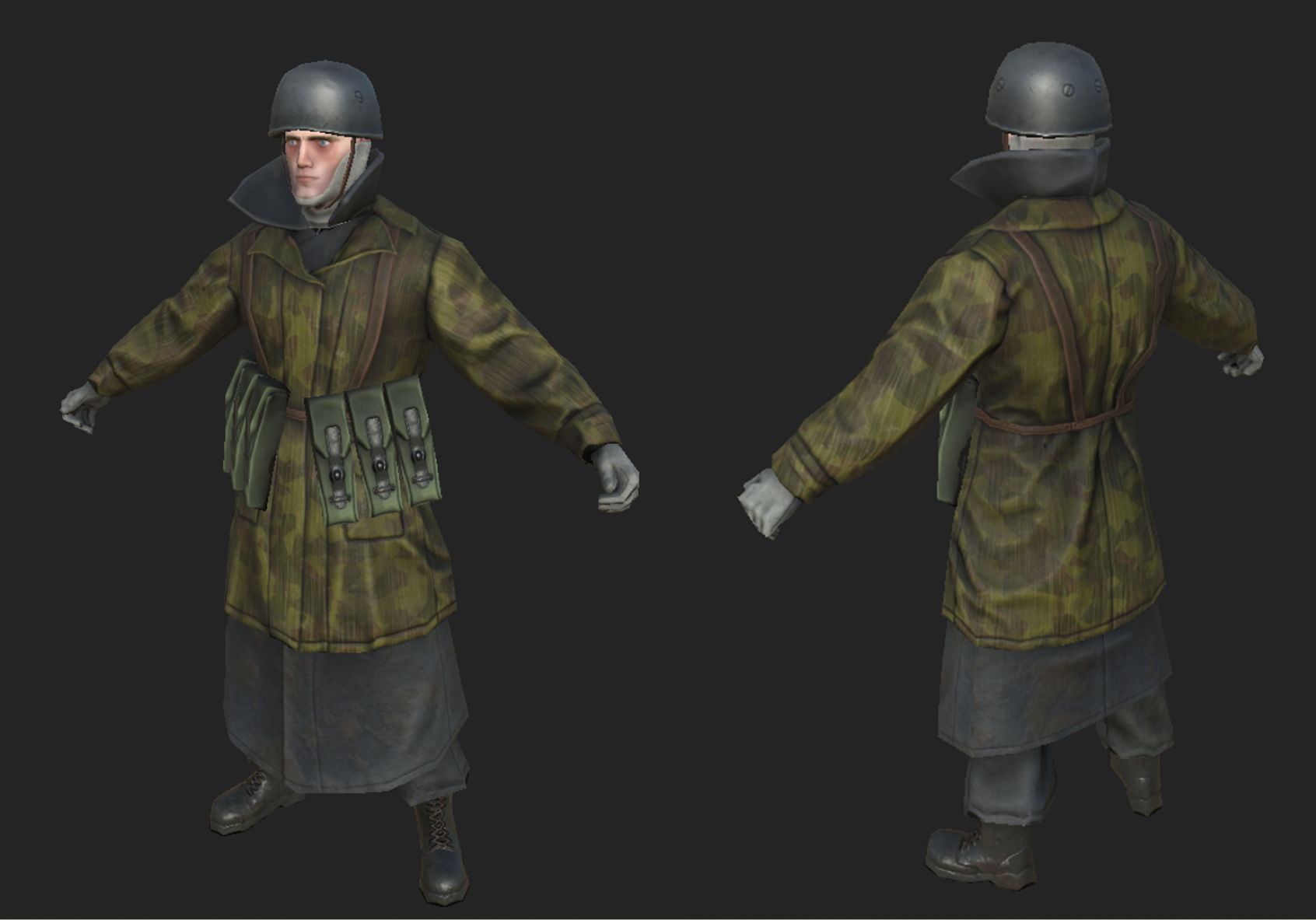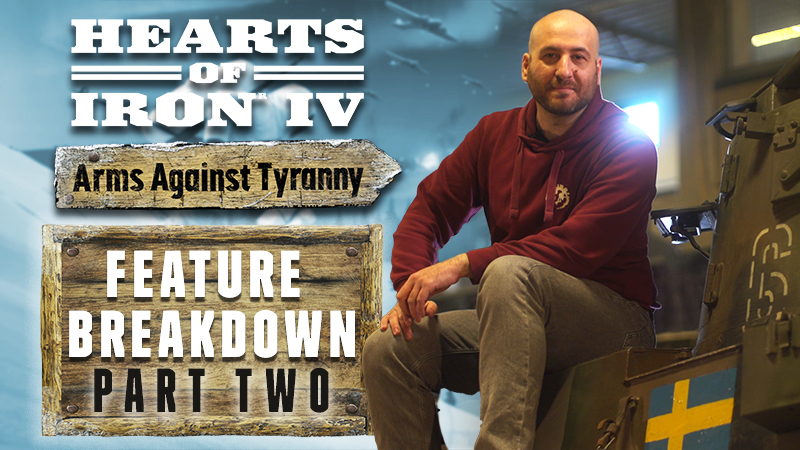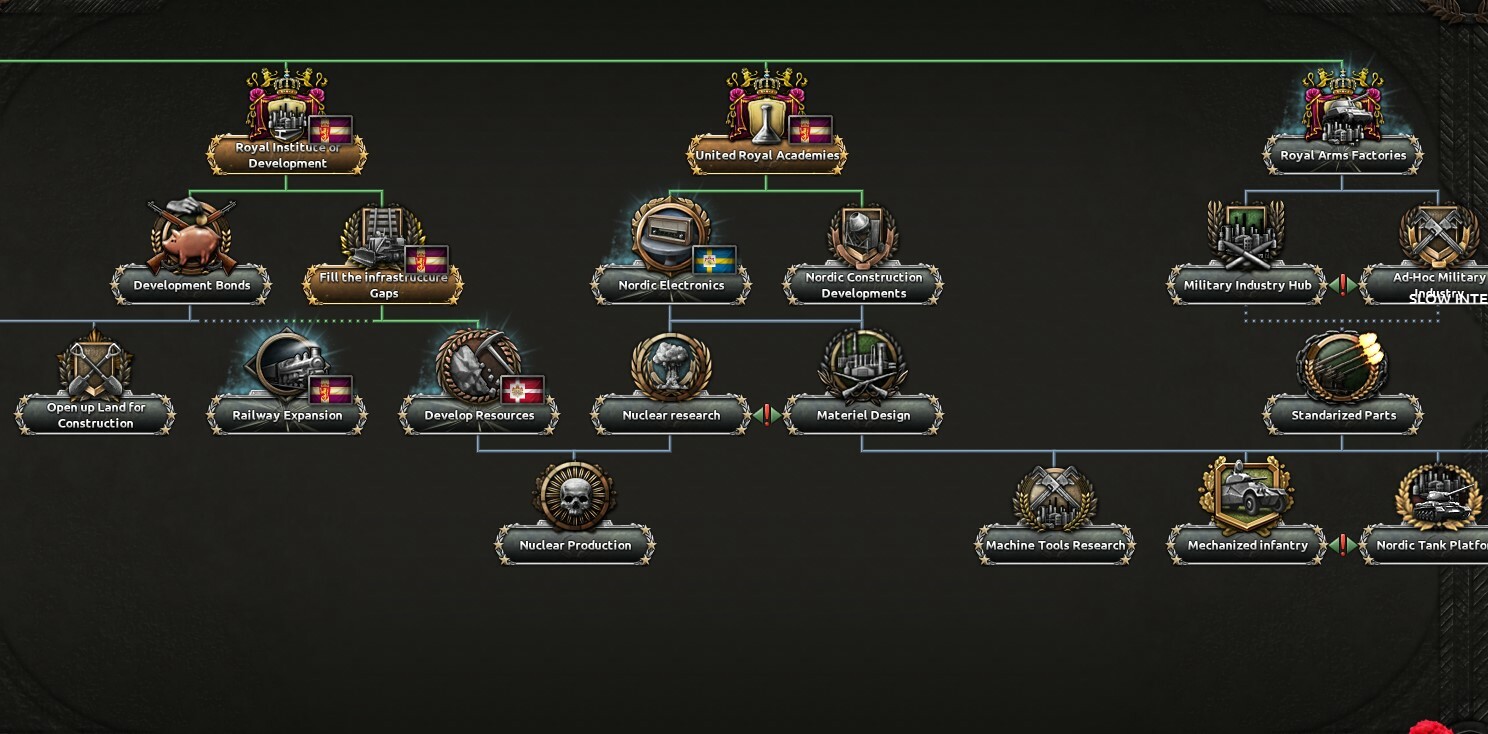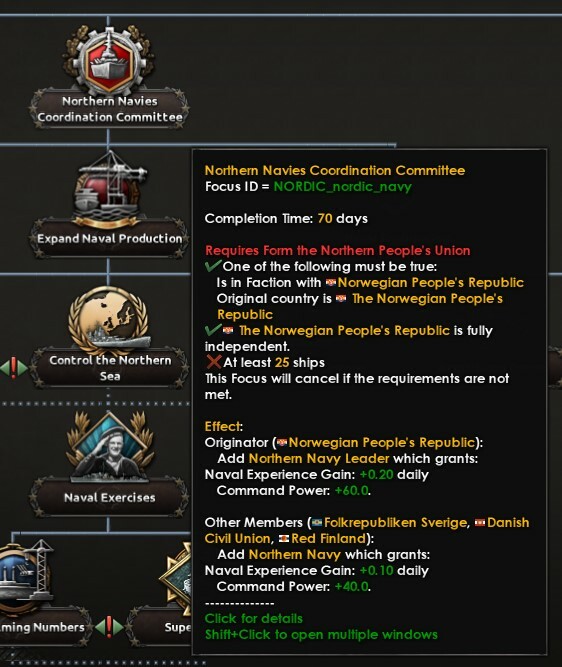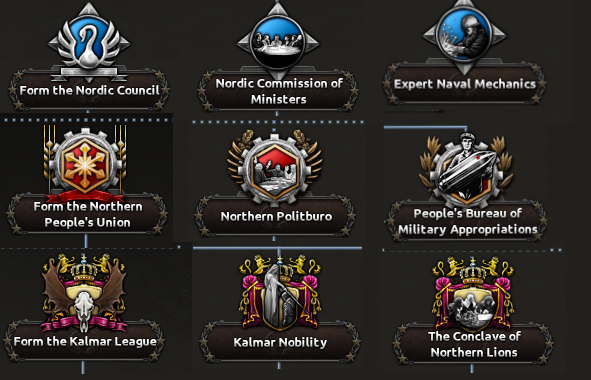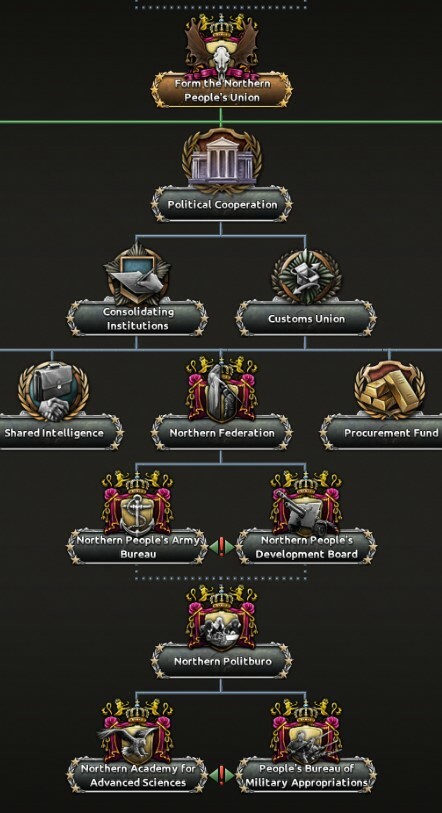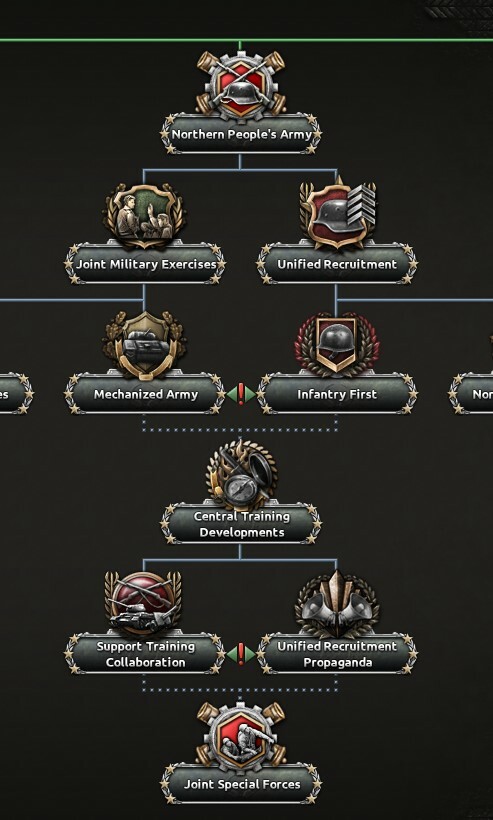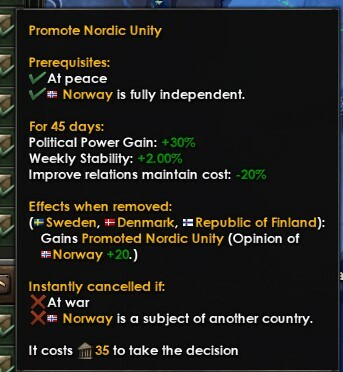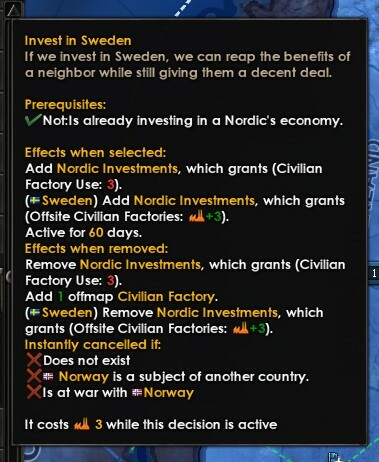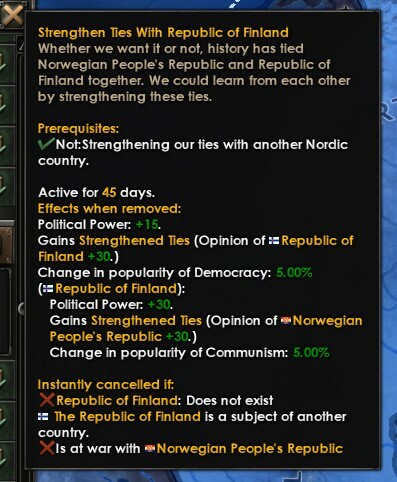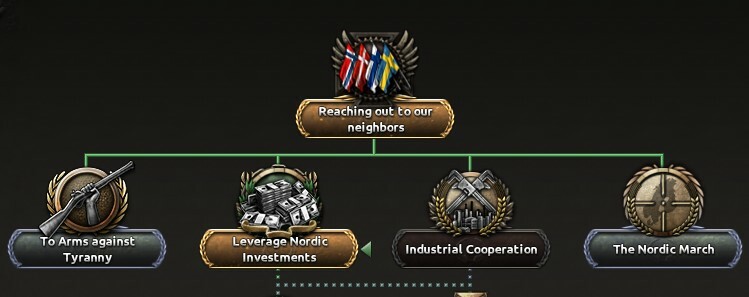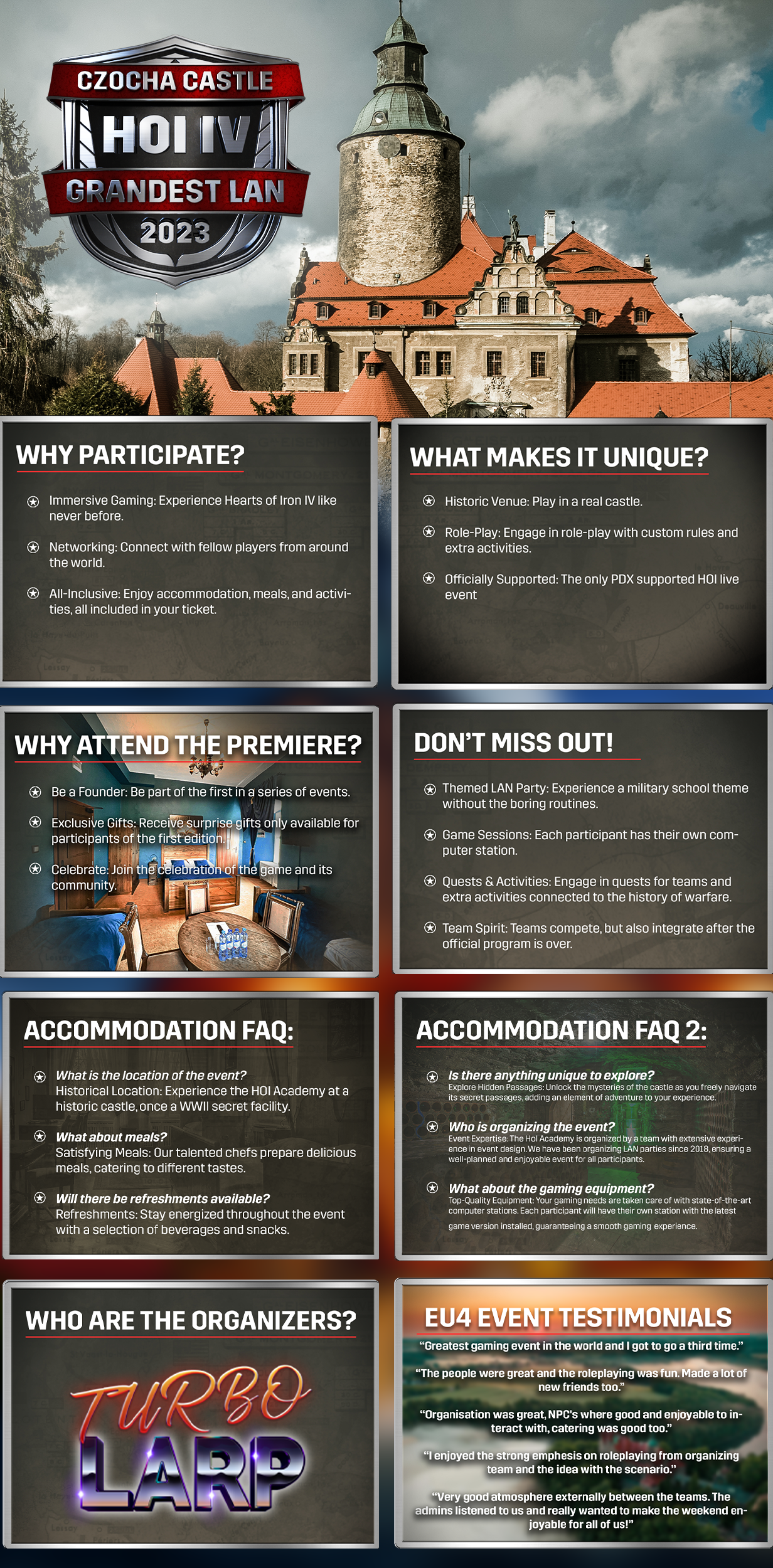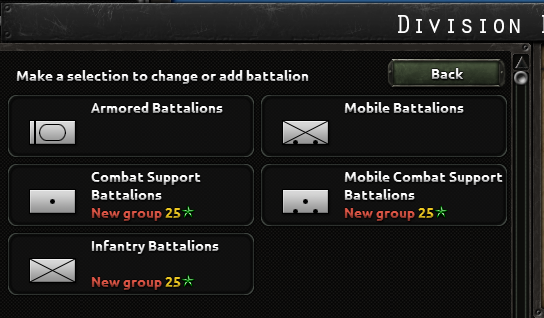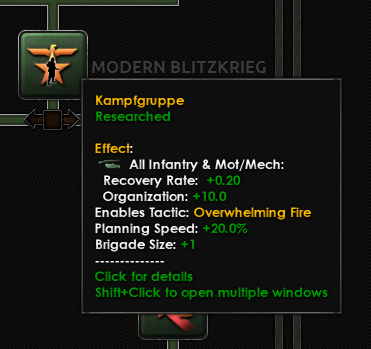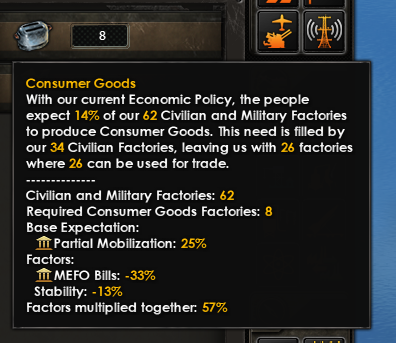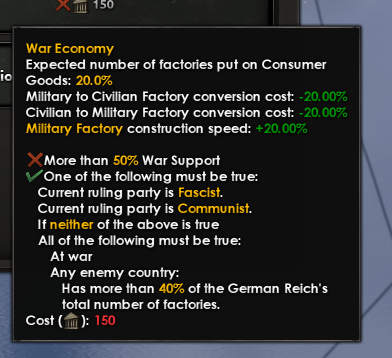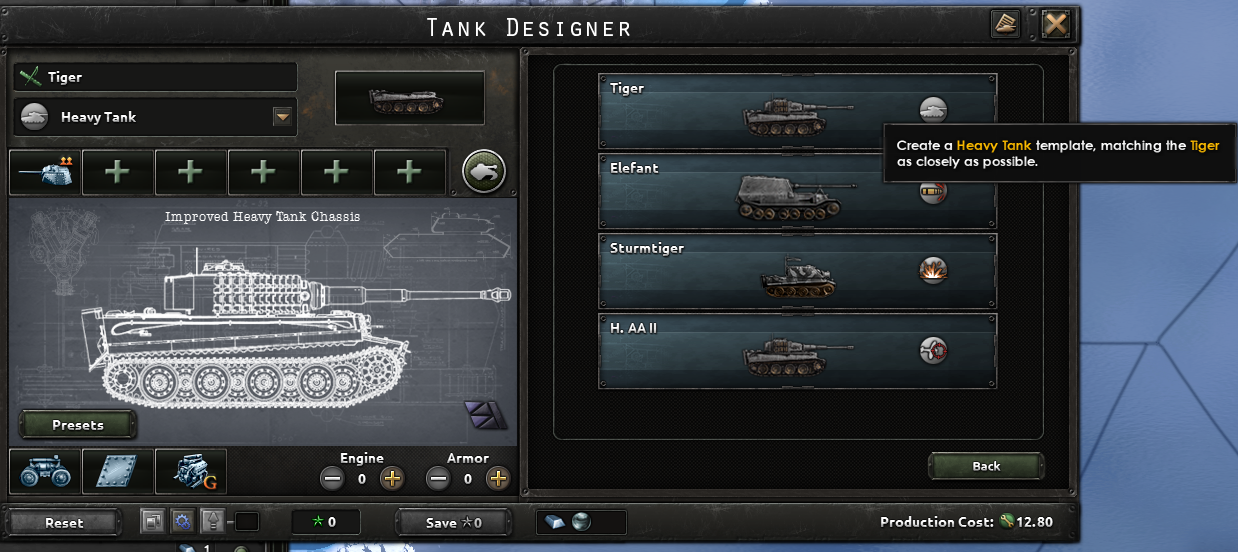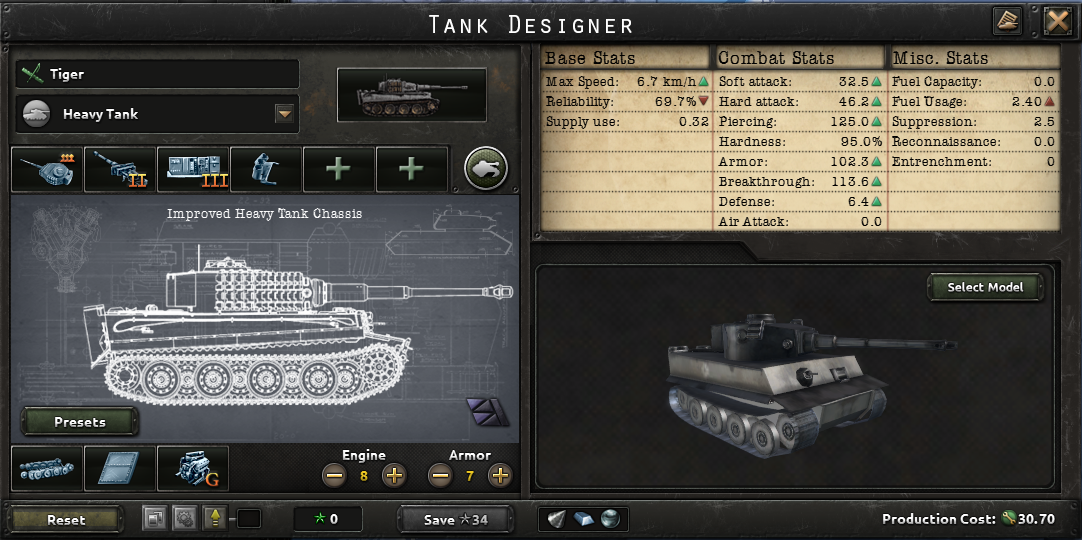
Aug 23, 2023
Hearts of Iron IV - PDX Chakerathe
Hej everyone, it’s me, Carlo! Katten has been staring at me from the other side of the office all morning, which can only mean one thing: it’s time for me to write another Dev Diary! Now, I’ve already talked about Historical Norway, the Joint Focus Tree, and modding stuff so there’s only one more thing I could write about, and that’s our favorite kamerat, LevTrotskij.
Known outside of Norway as Leon Trotsky, he was one of the most prominent members of the bolsheviks in the Soviet Union, renowned marxist theorist, known for his permanent revolution, and even more permanent exile. He was Lenin’s successor apparent, but Stanlin’s political maneuvering forced him out of the government and eventually out of the Soviet Union. After that, he was allowed to move to Norway, with the newspaper editor, Konrad Knudsen. So far so good.
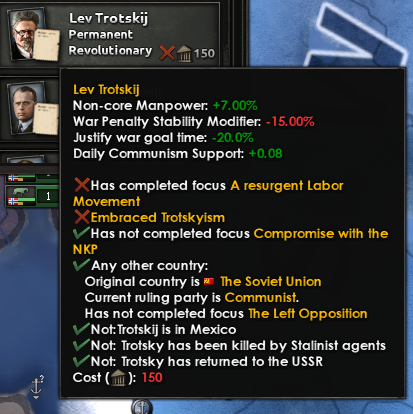
The important thing for us happens in an August much like this one, in 1936, when Quisling’s thugs ransacked Knudsen’s house, and would’ve gotten away with it if it wasn’t because Knudsen’s daughter drove them off. So much for the tolerant left, smh. This event will be represented in AAT’s Norway, regardless of the path you take, and it’s the start of trotskij’s event chain.
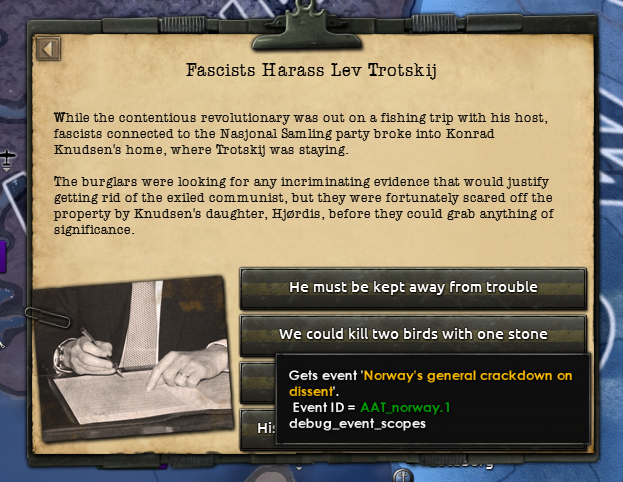
Historically, the pressure from fascists and stalinists was too much for the Nygaardsvold Cabinet, so he was put under house arrest in a farm in Hurum, which, by his own account, was one of the worst periods of his life. After that he was allowed into Mexico, and received by the artist Frida Kahlo and her husband Diego Rivera. And then they lived happily ever after. Though he was, indeed, kicked out when Diego Rivera found out he was having an affair with Frida Kahlo and then was killed with an ice pick by a Soviet Union agent. Other than that he had a good time in Mexico by all accounts.
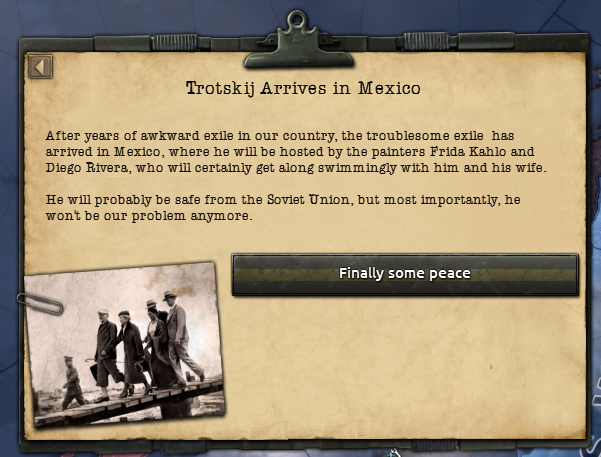
Of course, you don’t need to care about what happened historically. You can just imprison him, or send him to Mexico right away and use this altercation as a justification for increasing political repression, send him straight to Stalin, and even put him in government. Those last two are especially useful if you’re going the communist route by the way.
Communist Route?... Oh, right, that’s what I was supposed to write about, Alt History content for Norway! Since I already wrote about Trotskij's fate, let me tell you about the options you have for
turning Norway even redder.
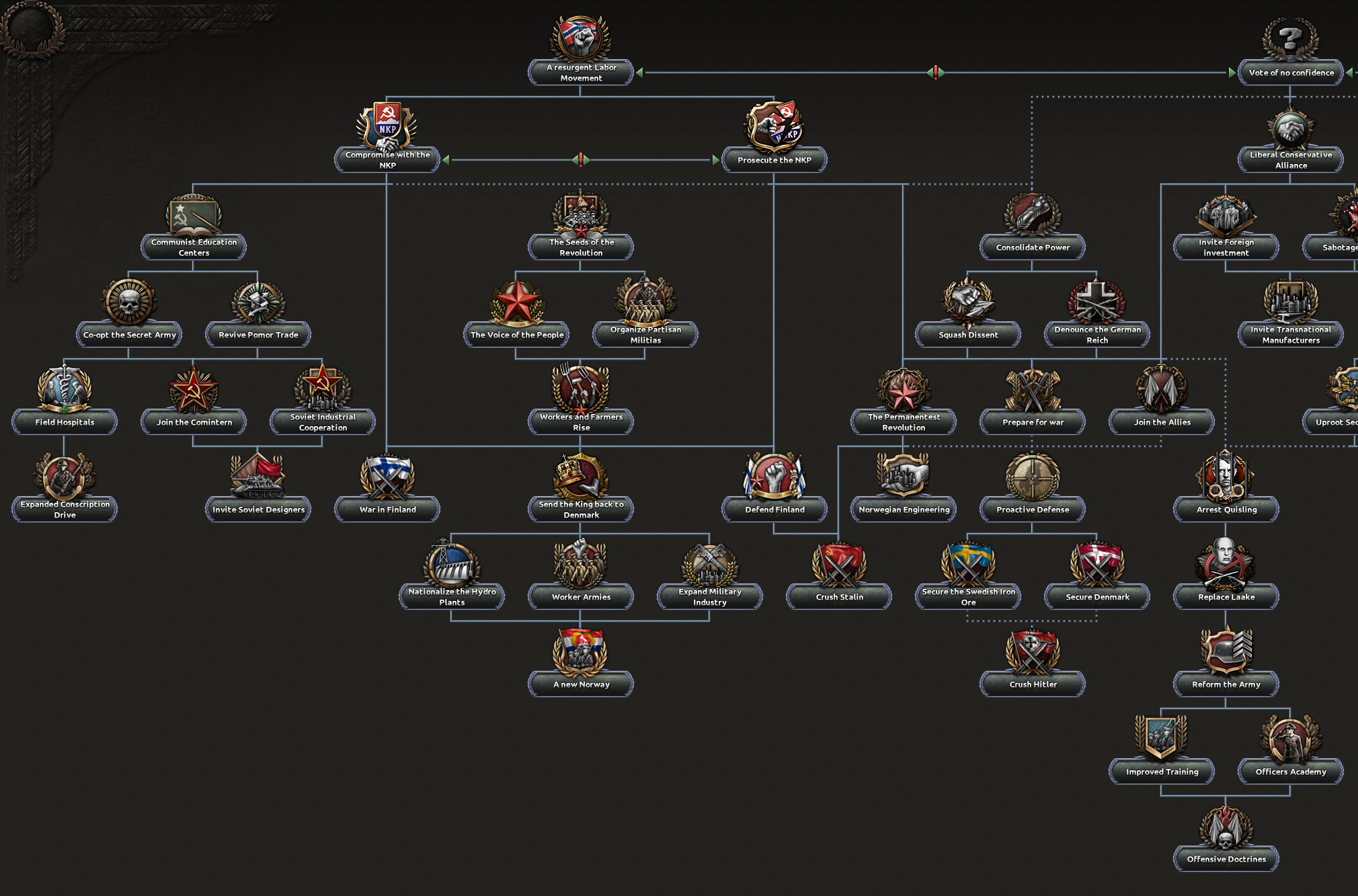
First step, the labor movement needs to regain its momentum, with the ‘A Resurgent Labor Movement’ focus. This will set Norway on to the path of Communism, but which one? You can compromise with the NKP to adopt their Stalinist stance or prosecute them and let the Labor Party embrace Trotskij’s teachings, and if you kept him in Norway you’ll also have him as an advisor and general.

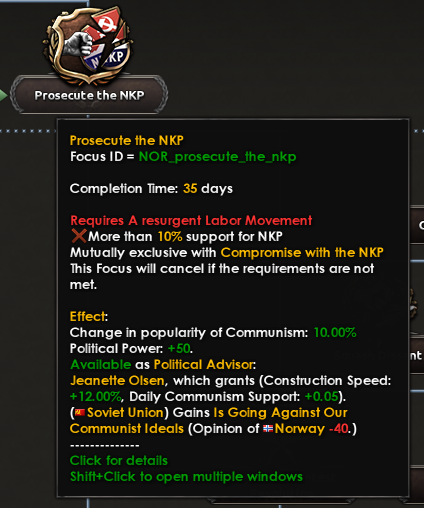
Each path has advantages and disadvantages: you can be beholden to the Soviet Union and their support, or you can go your own path and bring the Permanent Revolution to the rest of the world.
Regardless of your communist goals, you will need to rouse the proletariat in states that are industrialized enough, and when you’re ready you can trigger the communist revolution and fight in a civil war against the old Norway! Now of course, riling up the workers has its cost, because they’ll do some heavy damage to your factories and infrastructure once they rise up for the revolution.

Let’s take a better look at the ‘Rouse the Proletariat Decisions’. The first level will grant you the state once the civil war starts, but will leave your buildings in a pretty rough shape.
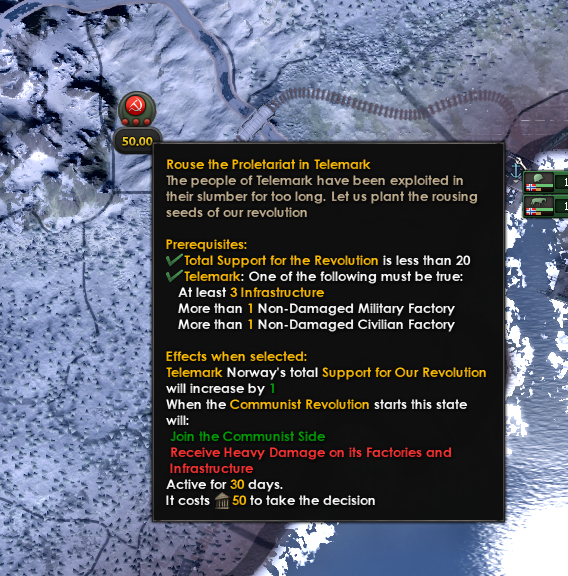
You can reduce this damage by bringing it to Level 2 and you will also be granted 2 irregular divisions.
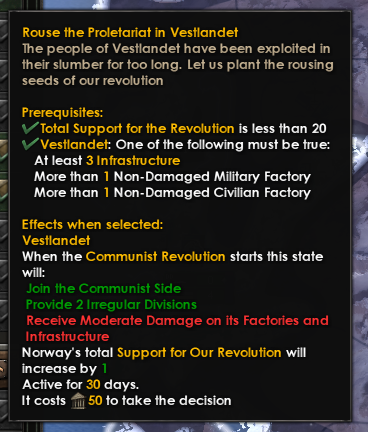
Then if you’re really serious about that state you can fully rouse its working class, reducing the damage to the buildings and upgrading those troops to Militias.
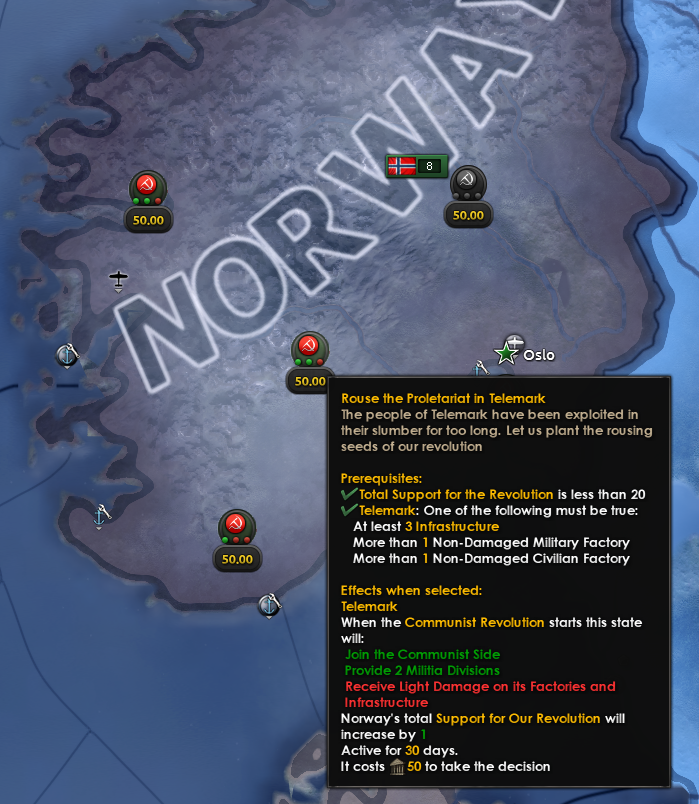
And before you think “But Carlo, what if I just rouse the whole country and I skip the civil war?”, I’ll tell you now, that won’t work. You will have to choose carefully how to approach these decisions, as you can’t go over 20 Total Support for the Revolution and no matter what, the other side will have Oslo.
Ok now, let’s go over the things you’ll be able to do once you’ve seized the means of production in Norway. If your senpai Stalin noticed you, there will be plenty of improvements to your industrial base, manpower and a close collaboration with the Soviet Union, and even help them invade Finland. Maybe the Arms Against Tyranny thing is just aspirational.
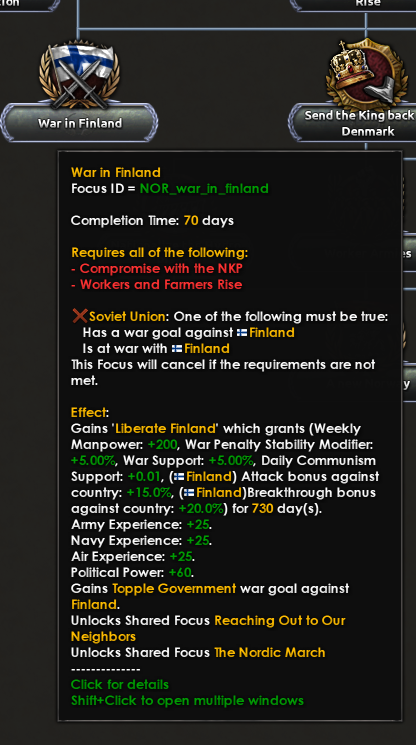
If instead, you decided to go with uncle trotskij, as I said before, you’ll get an extra advisor and general, and that will put you behind the wheel of your very own communist faction, the Norintern with the focus ‘The Permanentest Revolution’. That’s what it’s actually called, and nobody has complained about it so I guess the name is final? Defend Finland, bring the war to Stalin, Sweden, Norway and even Hitler, bringing about a new, Trotskyist world order.
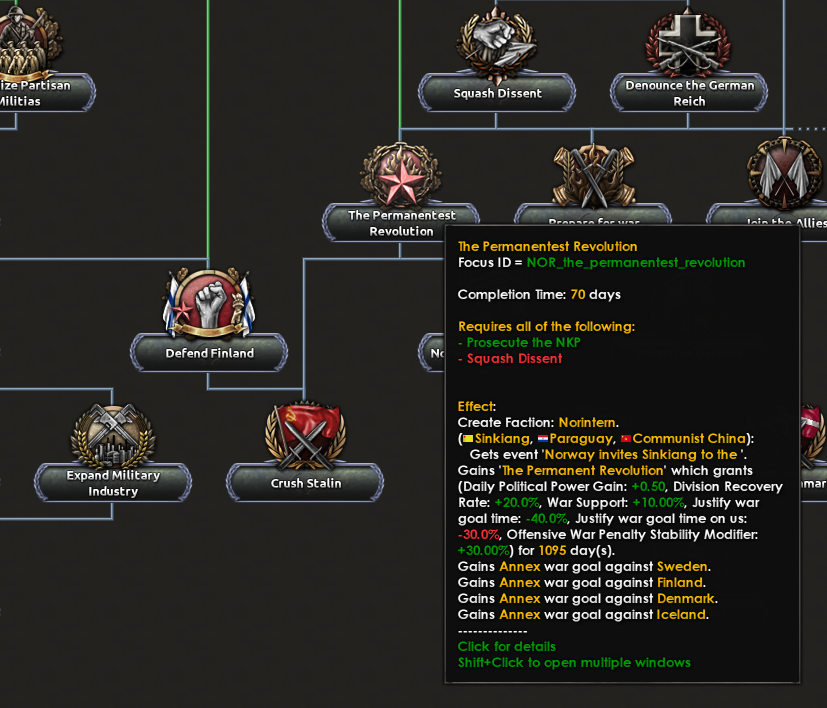
To summarize, with Stalin you’ll get soldiers and industry. With Trotsky you’ll get easy wargoals and offensive bonuses. Your pick.
Now let’s move slightly to the right. To the allied democratic branch, which starts with a fictional Vote of No confidence that the Nygaardsvold government loses. This branch is what happens when militaristic industry tycoons take control of the government. It overlaps somewhat with the democratic branch, except you can skip the whole Broken Gun thing and go straight for rearmament, so you’ll have more time to get ready for what’s coming, but at the cost of a lot of civilian industry.
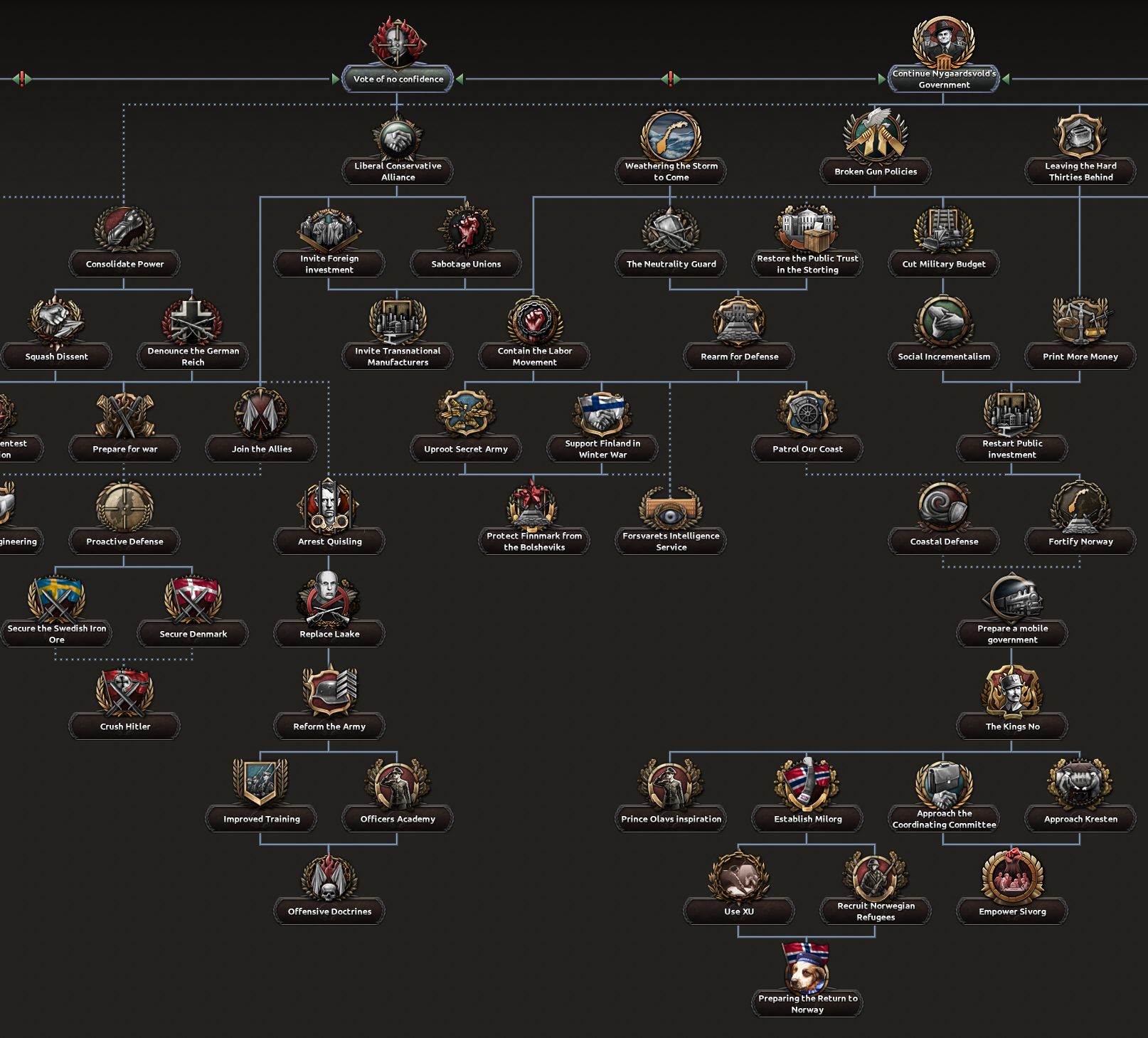
This path leads to a more centralized government, so all the local preparations are pooled together, letting you start nation-wide initiatives, both during peacetime and war time.
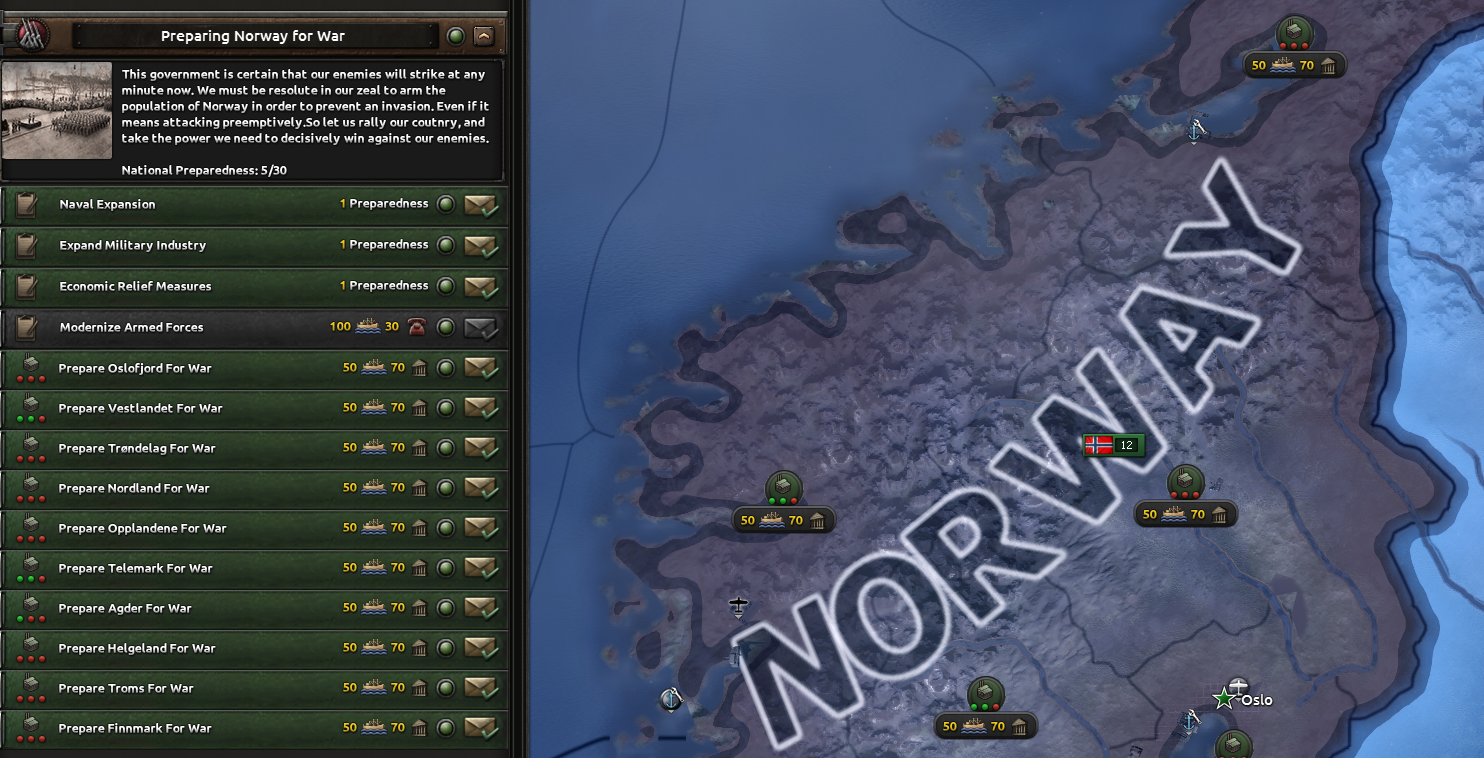
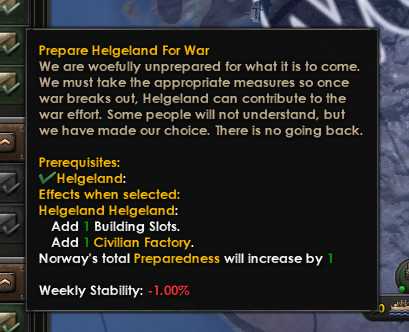
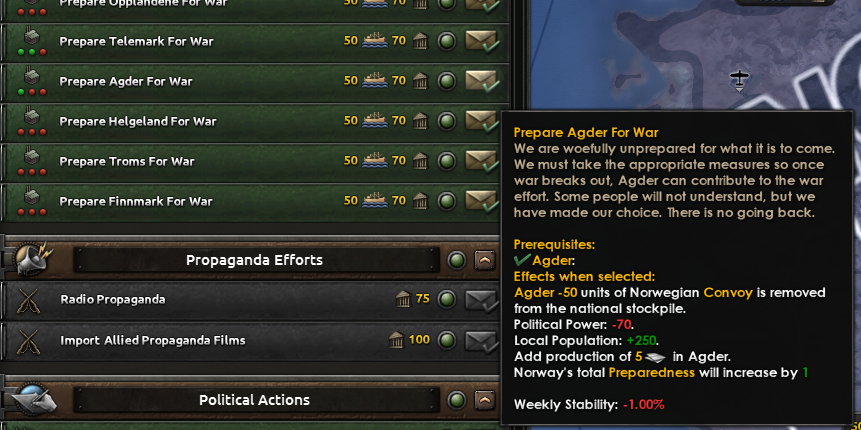
It also overlaps a little with the Trotskyist path, just not the commie parts, and you’ll be able to join the allies instead of forming your own faction.
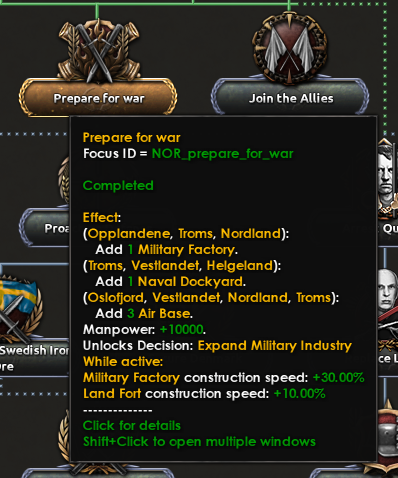
Let’s keep going, I have actual work to do, so I’m gonna skip the historical path. A few things have changed, but not enough to care, and the dog is still there so onwards to the fascist path, which, of course there is one.
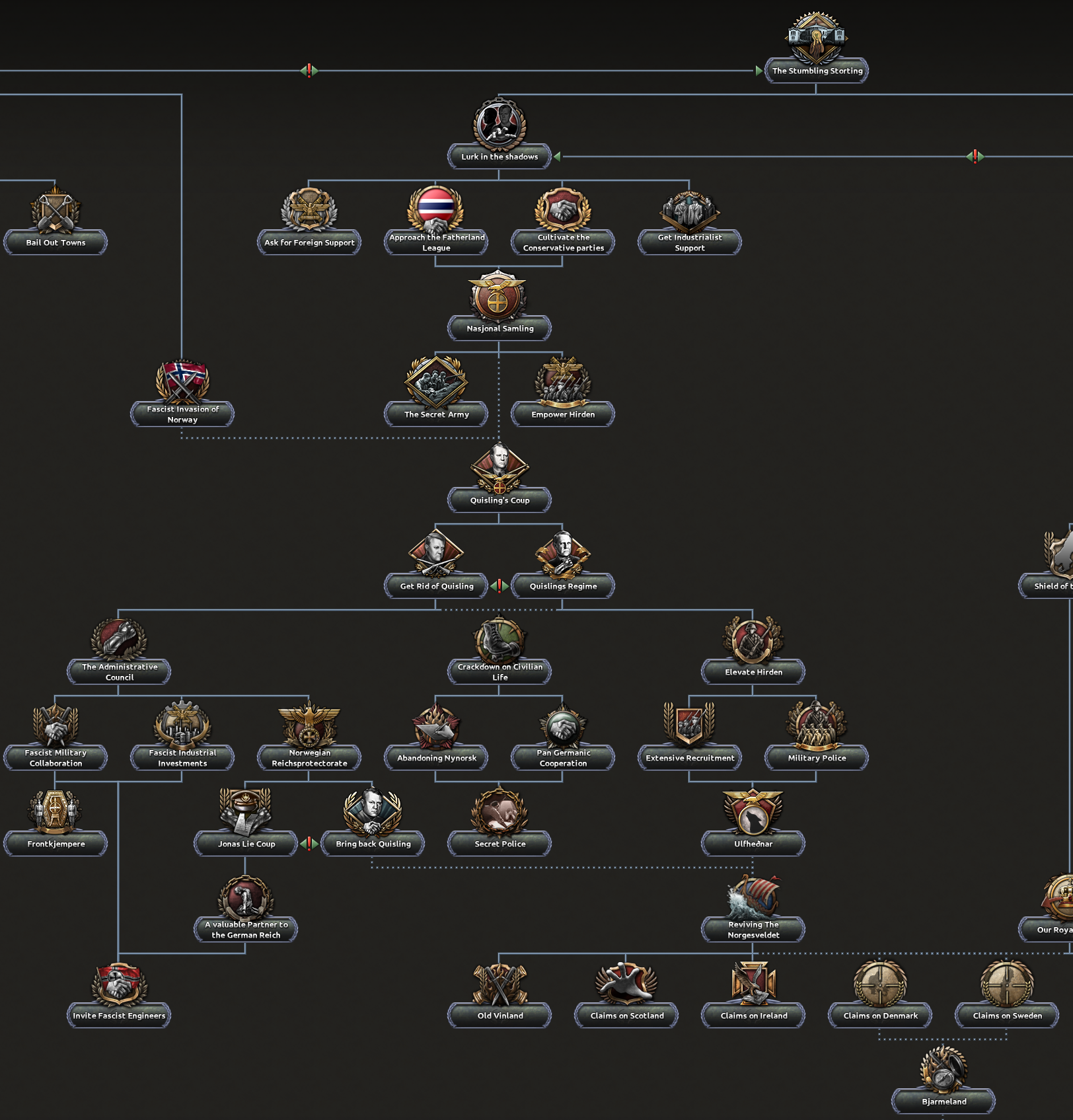
It starts with The Stumbling Storting, in this reality the labor party fails to secure political stability for Norway, leaving the door open to fascists, and other undesirables.
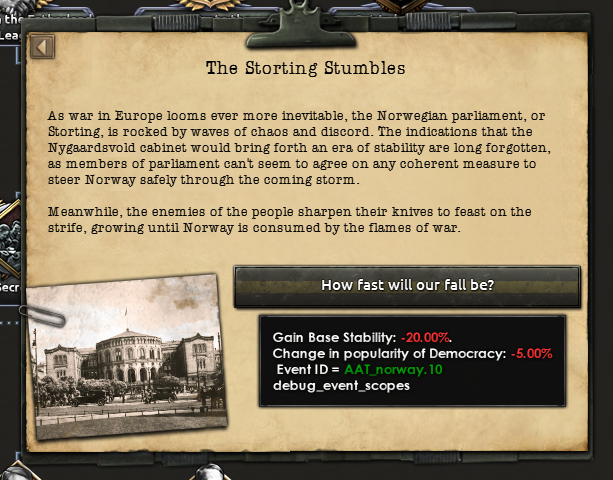
Let’s go with Undesirable Elements #1, fascists. In this scenario Quisling is somewhat good at making people think he’s competent and that fascism is reasonable. The Nasjonal Samling will lurk in the shadows and build support for their agenda state by state, seeking support from the Fatherland League (A proto-fascist nationalist movement), industrialists, conservatives and even fascists abroad.
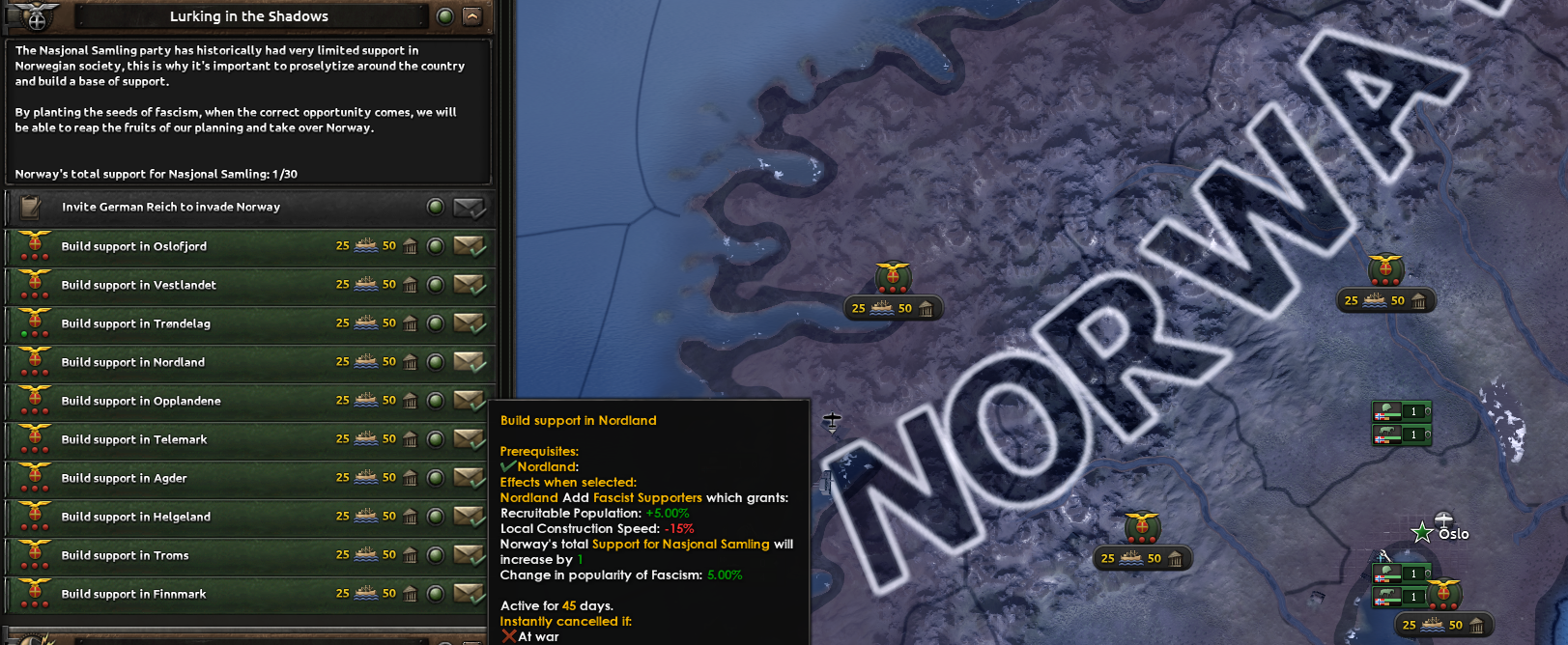
Eventually, you’ll reach a familiar focus, ‘Quisling’s Coup’, except this time, you’re ready for it, you have built the support needed to make the takeover as easy as possible for you and the foreign fascist invaders, whom you invited! Yes, in this path you can invite the most suitable fascist regime to invade Norway so you can take over the government and help them on their fascist crusade. Don’t worry if they say no, that rejection will also allow you to start the coup without them, who needs Hitler anyway.
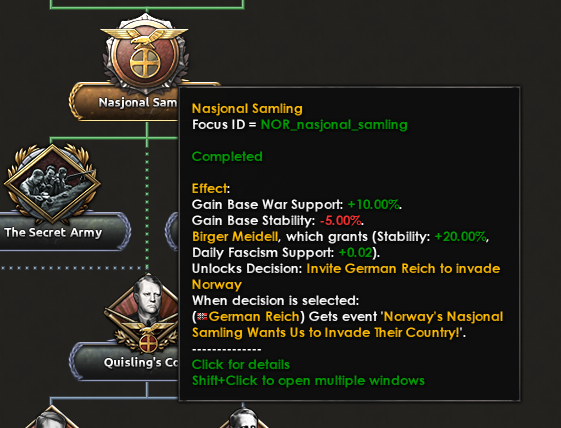
The coup, as expected, will trigger a civil war in which, unlike the communist one, you’ll only control Oslofjord. That’s alright though, you prepared for this, which means that you can take over states where you built support in. If you only prepared base level support, you’ll get the state, not too shabby! But if you built more support, you will be rewarded for your efforts with a brand new Military Factory, and maybe even a couple of militias too if you fully prepared it.
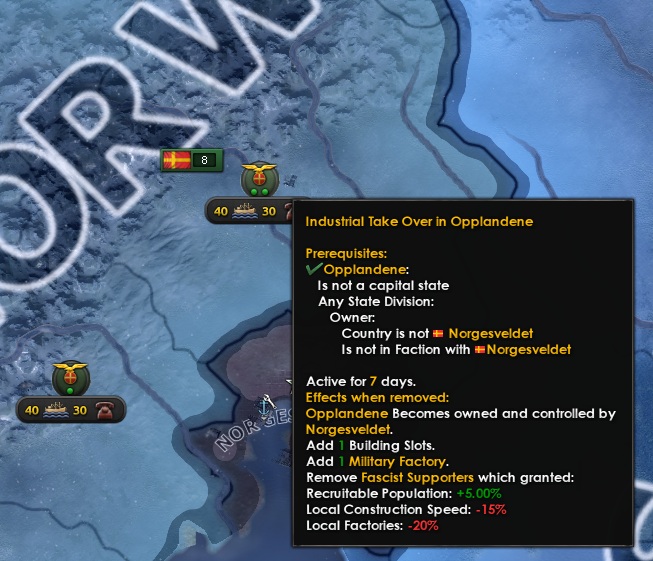
This should put you on the right footing to start your fascist campaign, have fun making the world a worse place! Eventually, you’ll make it to your outlandish viking theme claims around the North Atlantic. Classic.
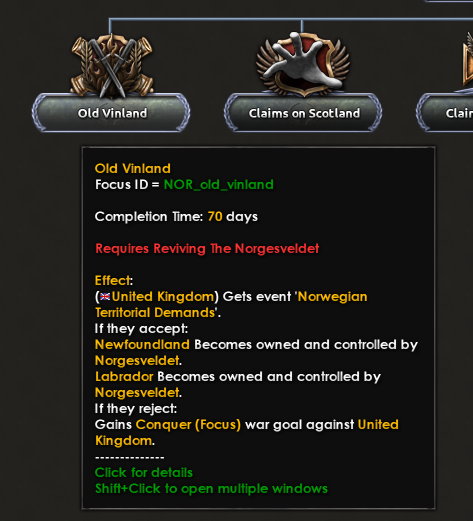
Now onto the last branch: The monarchist branch. For some reason a lot of people who want nordic focus trees also want a monarchist path, I can understand why, but I still think they’re wrong. I still made a monarchist path for Norway, whose king was reluctant to become their king, and even when he took over, by all accounts had no intention of becoming anything more than a figurehead.
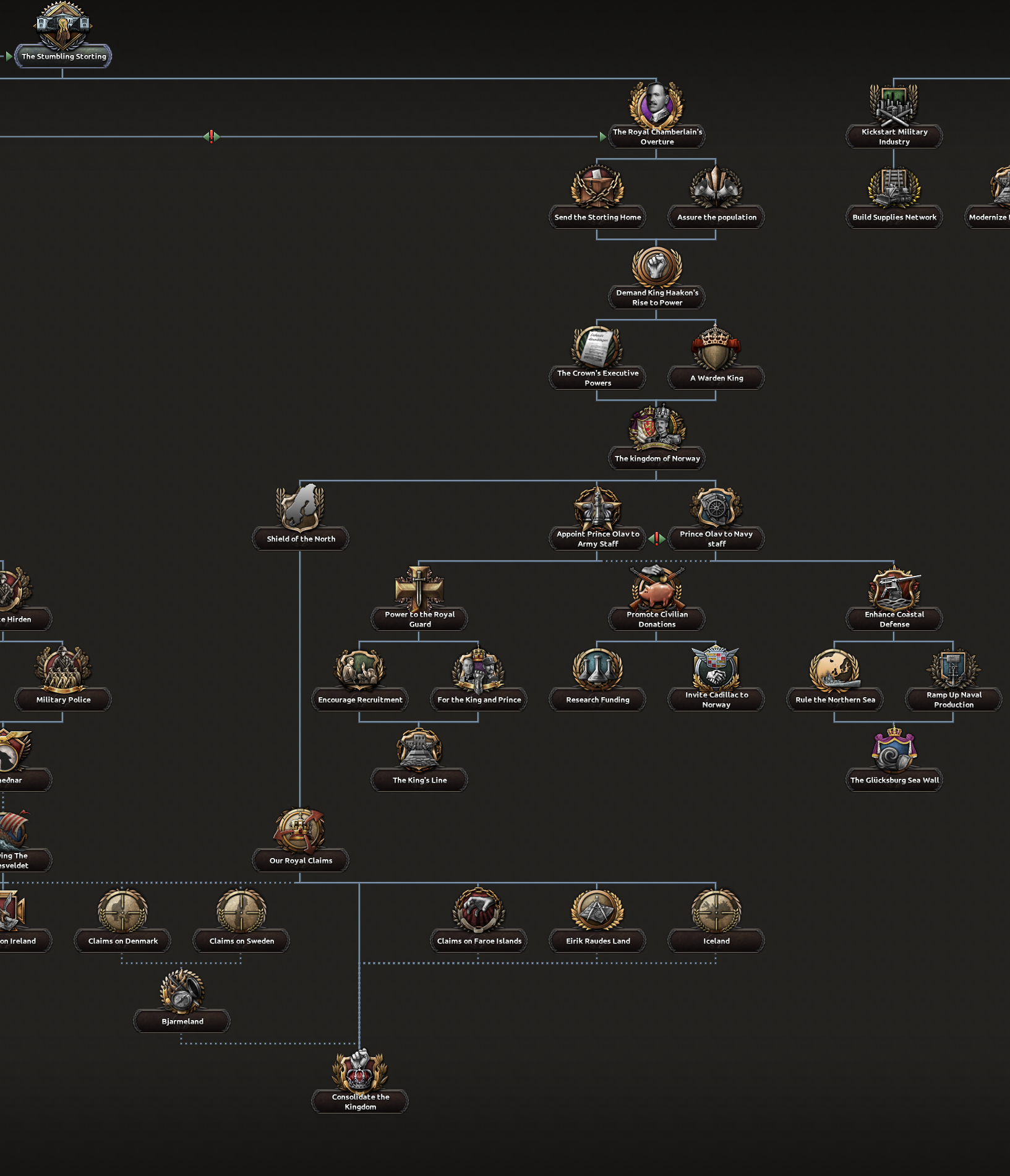
This reality starts much like the fascist one, with the Storting devolving into chaos, and the Royal Chamberlain, Anker Peder Wedel-Jarlsberg uses this opportunity to build support for a more involved monarchy, with his steady hand at the helm of course. Obviously, he is not part of the real Wedel-Jarlsberg noble family that lives in Norway, any similarities are purely coincidental, etc. He’s not Wedel-Jarlsberg with a ‘-’, his is a minus symbol. Just do me a favor and don’t tell the legal team, they don’t need to stress about it.
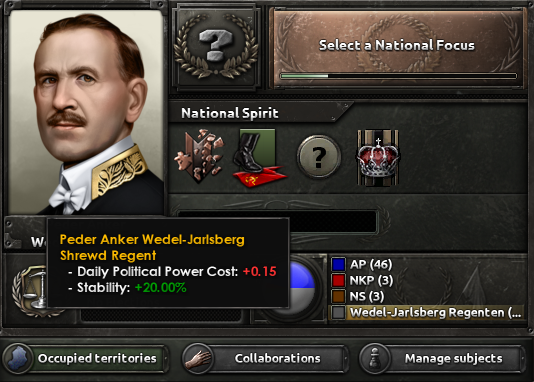
Peder Anker will travel all around Norway proselytizing his monarchist cause, giving you bonuses for building defensive buildings, and adding more building slots, which will of course reduce the available manpower in the state, because, you know, they’re all busy being monarchists so they don’t have time to be soldiers.
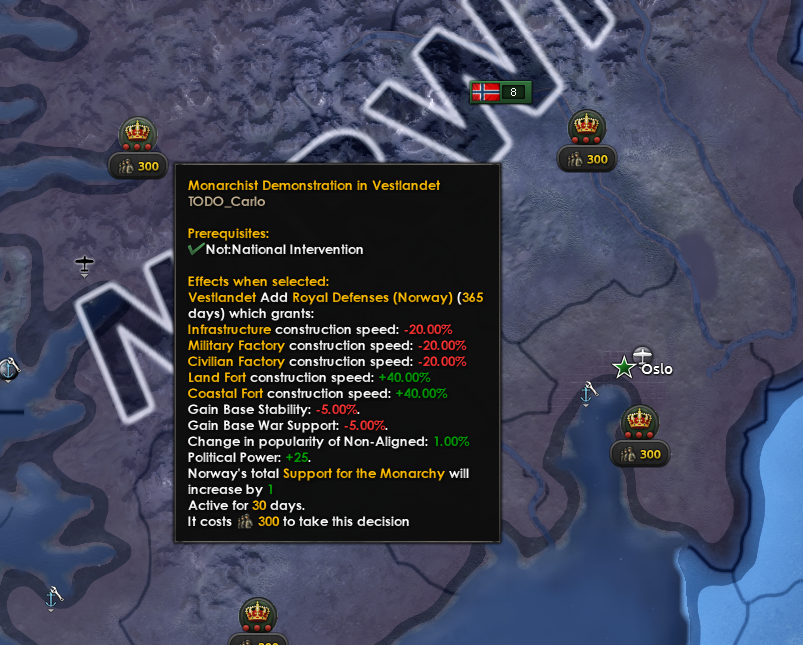
Except… If you go all the way with your monarchism you get 2 free militia divisions, and once you get the power as the Regent of Norway you can edit to your heart’s content. They’ve been so converted that they are now soldiers for monarchism.

Once the Absolutist Regency is the rule of the land you’ll recruit the crown prince, Olav to join either the Navy or Army staff, since he was indeed employed in both during the war. In this case you’ll probably want him dedicating all his efforts on one thing, so he can become either a General or an Admiral and will allow you to specialize your country further.
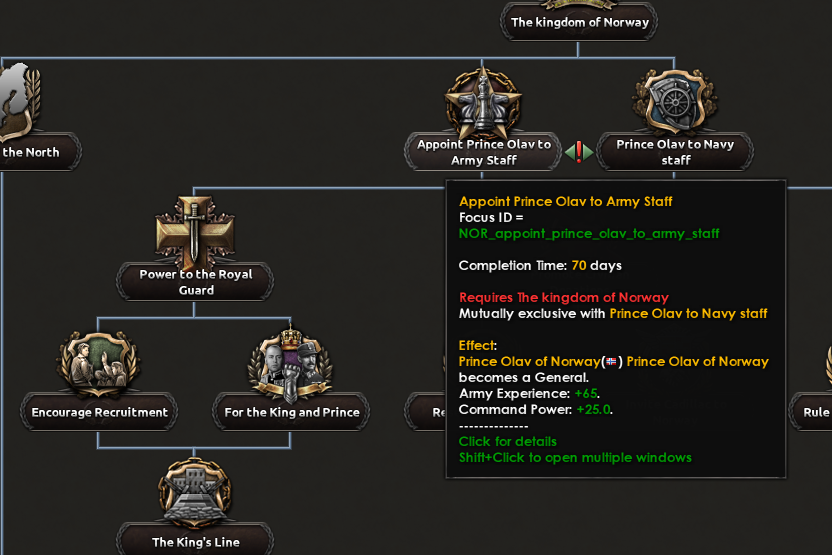
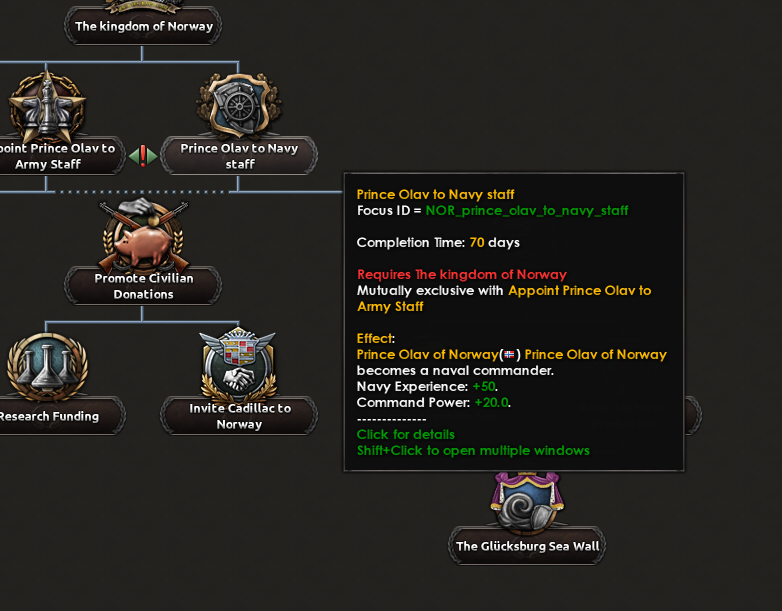
And of course you can get an extra set of outlandish claims. Faroe Islands, Iceland, Greenland, part of Russia, and even part of Sweden. At the end you’ll be able to consolidate your kingdom to make it easier for Peder Anker to rule over his king’s land.

And well that’s it. Obviously there’s tons more to unearth if you ask the right questions ;) and many more things I’ll either keep as a secret for release or haven’t implemented yet, like the new Trotskij portrait and the [Redacted] of [Redacted]. Also, don’t forget to stay tuned for the Sweden alt history Dev Diary, where you’ll see how wildly different the world would be if Sweden had privately managed vacation instead of state managed ones.
Known outside of Norway as Leon Trotsky, he was one of the most prominent members of the bolsheviks in the Soviet Union, renowned marxist theorist, known for his permanent revolution, and even more permanent exile. He was Lenin’s successor apparent, but Stanlin’s political maneuvering forced him out of the government and eventually out of the Soviet Union. After that, he was allowed to move to Norway, with the newspaper editor, Konrad Knudsen. So far so good.

The important thing for us happens in an August much like this one, in 1936, when Quisling’s thugs ransacked Knudsen’s house, and would’ve gotten away with it if it wasn’t because Knudsen’s daughter drove them off. So much for the tolerant left, smh. This event will be represented in AAT’s Norway, regardless of the path you take, and it’s the start of trotskij’s event chain.

Historically, the pressure from fascists and stalinists was too much for the Nygaardsvold Cabinet, so he was put under house arrest in a farm in Hurum, which, by his own account, was one of the worst periods of his life. After that he was allowed into Mexico, and received by the artist Frida Kahlo and her husband Diego Rivera. And then they lived happily ever after. Though he was, indeed, kicked out when Diego Rivera found out he was having an affair with Frida Kahlo and then was killed with an ice pick by a Soviet Union agent. Other than that he had a good time in Mexico by all accounts.

Of course, you don’t need to care about what happened historically. You can just imprison him, or send him to Mexico right away and use this altercation as a justification for increasing political repression, send him straight to Stalin, and even put him in government. Those last two are especially useful if you’re going the communist route by the way.
Communist Route?... Oh, right, that’s what I was supposed to write about, Alt History content for Norway! Since I already wrote about Trotskij's fate, let me tell you about the options you have for
turning Norway even redder.

First step, the labor movement needs to regain its momentum, with the ‘A Resurgent Labor Movement’ focus. This will set Norway on to the path of Communism, but which one? You can compromise with the NKP to adopt their Stalinist stance or prosecute them and let the Labor Party embrace Trotskij’s teachings, and if you kept him in Norway you’ll also have him as an advisor and general.


Each path has advantages and disadvantages: you can be beholden to the Soviet Union and their support, or you can go your own path and bring the Permanent Revolution to the rest of the world.
Regardless of your communist goals, you will need to rouse the proletariat in states that are industrialized enough, and when you’re ready you can trigger the communist revolution and fight in a civil war against the old Norway! Now of course, riling up the workers has its cost, because they’ll do some heavy damage to your factories and infrastructure once they rise up for the revolution.

Let’s take a better look at the ‘Rouse the Proletariat Decisions’. The first level will grant you the state once the civil war starts, but will leave your buildings in a pretty rough shape.

You can reduce this damage by bringing it to Level 2 and you will also be granted 2 irregular divisions.

Then if you’re really serious about that state you can fully rouse its working class, reducing the damage to the buildings and upgrading those troops to Militias.

And before you think “But Carlo, what if I just rouse the whole country and I skip the civil war?”, I’ll tell you now, that won’t work. You will have to choose carefully how to approach these decisions, as you can’t go over 20 Total Support for the Revolution and no matter what, the other side will have Oslo.
Ok now, let’s go over the things you’ll be able to do once you’ve seized the means of production in Norway. If your senpai Stalin noticed you, there will be plenty of improvements to your industrial base, manpower and a close collaboration with the Soviet Union, and even help them invade Finland. Maybe the Arms Against Tyranny thing is just aspirational.

If instead, you decided to go with uncle trotskij, as I said before, you’ll get an extra advisor and general, and that will put you behind the wheel of your very own communist faction, the Norintern with the focus ‘The Permanentest Revolution’. That’s what it’s actually called, and nobody has complained about it so I guess the name is final? Defend Finland, bring the war to Stalin, Sweden, Norway and even Hitler, bringing about a new, Trotskyist world order.

To summarize, with Stalin you’ll get soldiers and industry. With Trotsky you’ll get easy wargoals and offensive bonuses. Your pick.
Now let’s move slightly to the right. To the allied democratic branch, which starts with a fictional Vote of No confidence that the Nygaardsvold government loses. This branch is what happens when militaristic industry tycoons take control of the government. It overlaps somewhat with the democratic branch, except you can skip the whole Broken Gun thing and go straight for rearmament, so you’ll have more time to get ready for what’s coming, but at the cost of a lot of civilian industry.

This path leads to a more centralized government, so all the local preparations are pooled together, letting you start nation-wide initiatives, both during peacetime and war time.



It also overlaps a little with the Trotskyist path, just not the commie parts, and you’ll be able to join the allies instead of forming your own faction.

Let’s keep going, I have actual work to do, so I’m gonna skip the historical path. A few things have changed, but not enough to care, and the dog is still there so onwards to the fascist path, which, of course there is one.

It starts with The Stumbling Storting, in this reality the labor party fails to secure political stability for Norway, leaving the door open to fascists, and other undesirables.

Let’s go with Undesirable Elements #1, fascists. In this scenario Quisling is somewhat good at making people think he’s competent and that fascism is reasonable. The Nasjonal Samling will lurk in the shadows and build support for their agenda state by state, seeking support from the Fatherland League (A proto-fascist nationalist movement), industrialists, conservatives and even fascists abroad.

Eventually, you’ll reach a familiar focus, ‘Quisling’s Coup’, except this time, you’re ready for it, you have built the support needed to make the takeover as easy as possible for you and the foreign fascist invaders, whom you invited! Yes, in this path you can invite the most suitable fascist regime to invade Norway so you can take over the government and help them on their fascist crusade. Don’t worry if they say no, that rejection will also allow you to start the coup without them, who needs Hitler anyway.

The coup, as expected, will trigger a civil war in which, unlike the communist one, you’ll only control Oslofjord. That’s alright though, you prepared for this, which means that you can take over states where you built support in. If you only prepared base level support, you’ll get the state, not too shabby! But if you built more support, you will be rewarded for your efforts with a brand new Military Factory, and maybe even a couple of militias too if you fully prepared it.

This should put you on the right footing to start your fascist campaign, have fun making the world a worse place! Eventually, you’ll make it to your outlandish viking theme claims around the North Atlantic. Classic.

Now onto the last branch: The monarchist branch. For some reason a lot of people who want nordic focus trees also want a monarchist path, I can understand why, but I still think they’re wrong. I still made a monarchist path for Norway, whose king was reluctant to become their king, and even when he took over, by all accounts had no intention of becoming anything more than a figurehead.

This reality starts much like the fascist one, with the Storting devolving into chaos, and the Royal Chamberlain, Anker Peder Wedel-Jarlsberg uses this opportunity to build support for a more involved monarchy, with his steady hand at the helm of course. Obviously, he is not part of the real Wedel-Jarlsberg noble family that lives in Norway, any similarities are purely coincidental, etc. He’s not Wedel-Jarlsberg with a ‘-’, his is a minus symbol. Just do me a favor and don’t tell the legal team, they don’t need to stress about it.

Peder Anker will travel all around Norway proselytizing his monarchist cause, giving you bonuses for building defensive buildings, and adding more building slots, which will of course reduce the available manpower in the state, because, you know, they’re all busy being monarchists so they don’t have time to be soldiers.

Except… If you go all the way with your monarchism you get 2 free militia divisions, and once you get the power as the Regent of Norway you can edit to your heart’s content. They’ve been so converted that they are now soldiers for monarchism.

Once the Absolutist Regency is the rule of the land you’ll recruit the crown prince, Olav to join either the Navy or Army staff, since he was indeed employed in both during the war. In this case you’ll probably want him dedicating all his efforts on one thing, so he can become either a General or an Admiral and will allow you to specialize your country further.


And of course you can get an extra set of outlandish claims. Faroe Islands, Iceland, Greenland, part of Russia, and even part of Sweden. At the end you’ll be able to consolidate your kingdom to make it easier for Peder Anker to rule over his king’s land.

And well that’s it. Obviously there’s tons more to unearth if you ask the right questions ;) and many more things I’ll either keep as a secret for release or haven’t implemented yet, like the new Trotskij portrait and the [Redacted] of [Redacted]. Also, don’t forget to stay tuned for the Sweden alt history Dev Diary, where you’ll see how wildly different the world would be if Sweden had privately managed vacation instead of state managed ones.






